Factors Affecting Customer Loyalty in Context of Banglalink in Bangladesh
VerifiedAdded on 2021/08/16
|21
|6173
|119
AI Summary
Contribute Materials
Your contribution can guide someone’s learning journey. Share your
documents today.
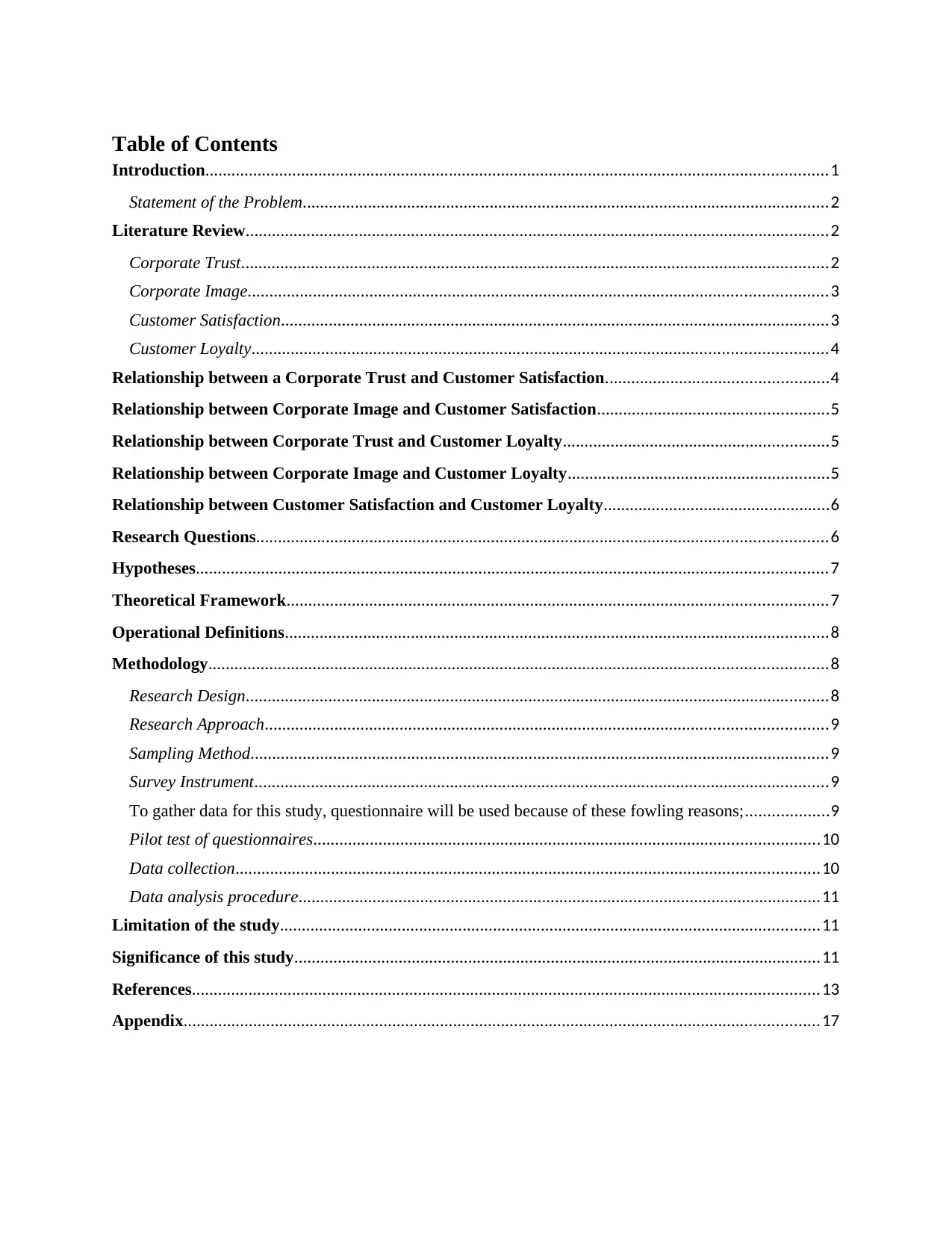
Table of Contents
Introduction...............................................................................................................................................1
Statement of the Problem.........................................................................................................................2
Literature Review......................................................................................................................................2
Corporate Trust.......................................................................................................................................2
Corporate Image.....................................................................................................................................3
Customer Satisfaction..............................................................................................................................3
Customer Loyalty....................................................................................................................................4
Relationship between a Corporate Trust and Customer Satisfaction...................................................4
Relationship between Corporate Image and Customer Satisfaction.....................................................5
Relationship between Corporate Trust and Customer Loyalty.............................................................5
Relationship between Corporate Image and Customer Loyalty............................................................5
Relationship between Customer Satisfaction and Customer Loyalty....................................................6
Research Questions...................................................................................................................................6
Hypotheses.................................................................................................................................................7
Theoretical Framework............................................................................................................................7
Operational Definitions.............................................................................................................................8
Methodology..............................................................................................................................................8
Research Design......................................................................................................................................8
Research Approach.................................................................................................................................9
Sampling Method.....................................................................................................................................9
Survey Instrument....................................................................................................................................9
To gather data for this study, questionnaire will be used because of these fowling reasons;...................9
Pilot test of questionnaires....................................................................................................................10
Data collection......................................................................................................................................10
Data analysis procedure........................................................................................................................11
Limitation of the study............................................................................................................................11
Significance of this study.........................................................................................................................11
References................................................................................................................................................13
Appendix..................................................................................................................................................17
Introduction...............................................................................................................................................1
Statement of the Problem.........................................................................................................................2
Literature Review......................................................................................................................................2
Corporate Trust.......................................................................................................................................2
Corporate Image.....................................................................................................................................3
Customer Satisfaction..............................................................................................................................3
Customer Loyalty....................................................................................................................................4
Relationship between a Corporate Trust and Customer Satisfaction...................................................4
Relationship between Corporate Image and Customer Satisfaction.....................................................5
Relationship between Corporate Trust and Customer Loyalty.............................................................5
Relationship between Corporate Image and Customer Loyalty............................................................5
Relationship between Customer Satisfaction and Customer Loyalty....................................................6
Research Questions...................................................................................................................................6
Hypotheses.................................................................................................................................................7
Theoretical Framework............................................................................................................................7
Operational Definitions.............................................................................................................................8
Methodology..............................................................................................................................................8
Research Design......................................................................................................................................8
Research Approach.................................................................................................................................9
Sampling Method.....................................................................................................................................9
Survey Instrument....................................................................................................................................9
To gather data for this study, questionnaire will be used because of these fowling reasons;...................9
Pilot test of questionnaires....................................................................................................................10
Data collection......................................................................................................................................10
Data analysis procedure........................................................................................................................11
Limitation of the study............................................................................................................................11
Significance of this study.........................................................................................................................11
References................................................................................................................................................13
Appendix..................................................................................................................................................17
Secure Best Marks with AI Grader
Need help grading? Try our AI Grader for instant feedback on your assignments.
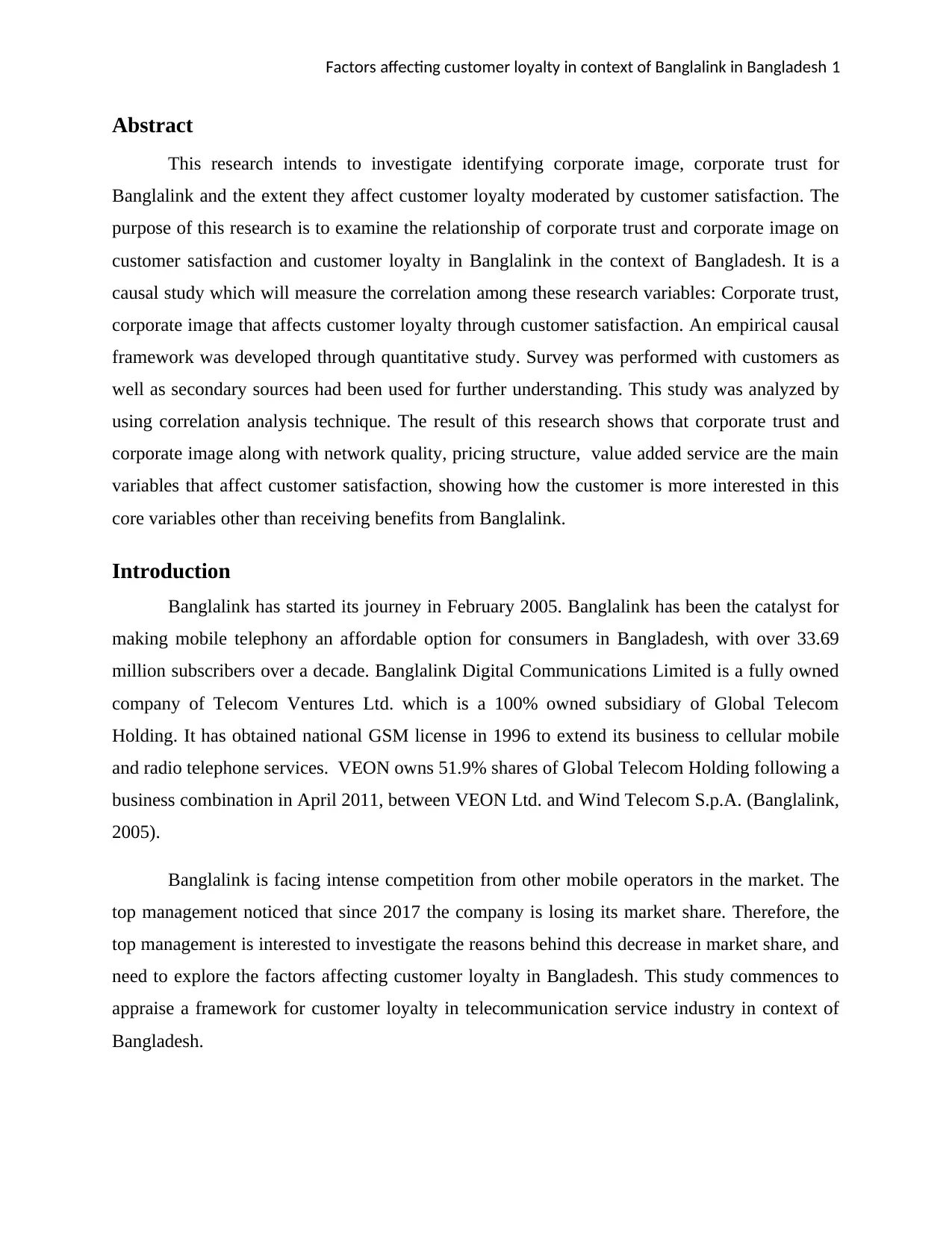
Factors affecting customer loyalty in context of Banglalink in Bangladesh 1
Abstract
This research intends to investigate identifying corporate image, corporate trust for
Banglalink and the extent they affect customer loyalty moderated by customer satisfaction. The
purpose of this research is to examine the relationship of corporate trust and corporate image on
customer satisfaction and customer loyalty in Banglalink in the context of Bangladesh. It is a
causal study which will measure the correlation among these research variables: Corporate trust,
corporate image that affects customer loyalty through customer satisfaction. An empirical causal
framework was developed through quantitative study. Survey was performed with customers as
well as secondary sources had been used for further understanding. This study was analyzed by
using correlation analysis technique. The result of this research shows that corporate trust and
corporate image along with network quality, pricing structure, value added service are the main
variables that affect customer satisfaction, showing how the customer is more interested in this
core variables other than receiving benefits from Banglalink.
Introduction
Banglalink has started its journey in February 2005. Banglalink has been the catalyst for
making mobile telephony an affordable option for consumers in Bangladesh, with over 33.69
million subscribers over a decade. Banglalink Digital Communications Limited is a fully owned
company of Telecom Ventures Ltd. which is a 100% owned subsidiary of Global Telecom
Holding. It has obtained national GSM license in 1996 to extend its business to cellular mobile
and radio telephone services. VEON owns 51.9% shares of Global Telecom Holding following a
business combination in April 2011, between VEON Ltd. and Wind Telecom S.p.A. (Banglalink,
2005).
Banglalink is facing intense competition from other mobile operators in the market. The
top management noticed that since 2017 the company is losing its market share. Therefore, the
top management is interested to investigate the reasons behind this decrease in market share, and
need to explore the factors affecting customer loyalty in Bangladesh. This study commences to
appraise a framework for customer loyalty in telecommunication service industry in context of
Bangladesh.
Abstract
This research intends to investigate identifying corporate image, corporate trust for
Banglalink and the extent they affect customer loyalty moderated by customer satisfaction. The
purpose of this research is to examine the relationship of corporate trust and corporate image on
customer satisfaction and customer loyalty in Banglalink in the context of Bangladesh. It is a
causal study which will measure the correlation among these research variables: Corporate trust,
corporate image that affects customer loyalty through customer satisfaction. An empirical causal
framework was developed through quantitative study. Survey was performed with customers as
well as secondary sources had been used for further understanding. This study was analyzed by
using correlation analysis technique. The result of this research shows that corporate trust and
corporate image along with network quality, pricing structure, value added service are the main
variables that affect customer satisfaction, showing how the customer is more interested in this
core variables other than receiving benefits from Banglalink.
Introduction
Banglalink has started its journey in February 2005. Banglalink has been the catalyst for
making mobile telephony an affordable option for consumers in Bangladesh, with over 33.69
million subscribers over a decade. Banglalink Digital Communications Limited is a fully owned
company of Telecom Ventures Ltd. which is a 100% owned subsidiary of Global Telecom
Holding. It has obtained national GSM license in 1996 to extend its business to cellular mobile
and radio telephone services. VEON owns 51.9% shares of Global Telecom Holding following a
business combination in April 2011, between VEON Ltd. and Wind Telecom S.p.A. (Banglalink,
2005).
Banglalink is facing intense competition from other mobile operators in the market. The
top management noticed that since 2017 the company is losing its market share. Therefore, the
top management is interested to investigate the reasons behind this decrease in market share, and
need to explore the factors affecting customer loyalty in Bangladesh. This study commences to
appraise a framework for customer loyalty in telecommunication service industry in context of
Bangladesh.
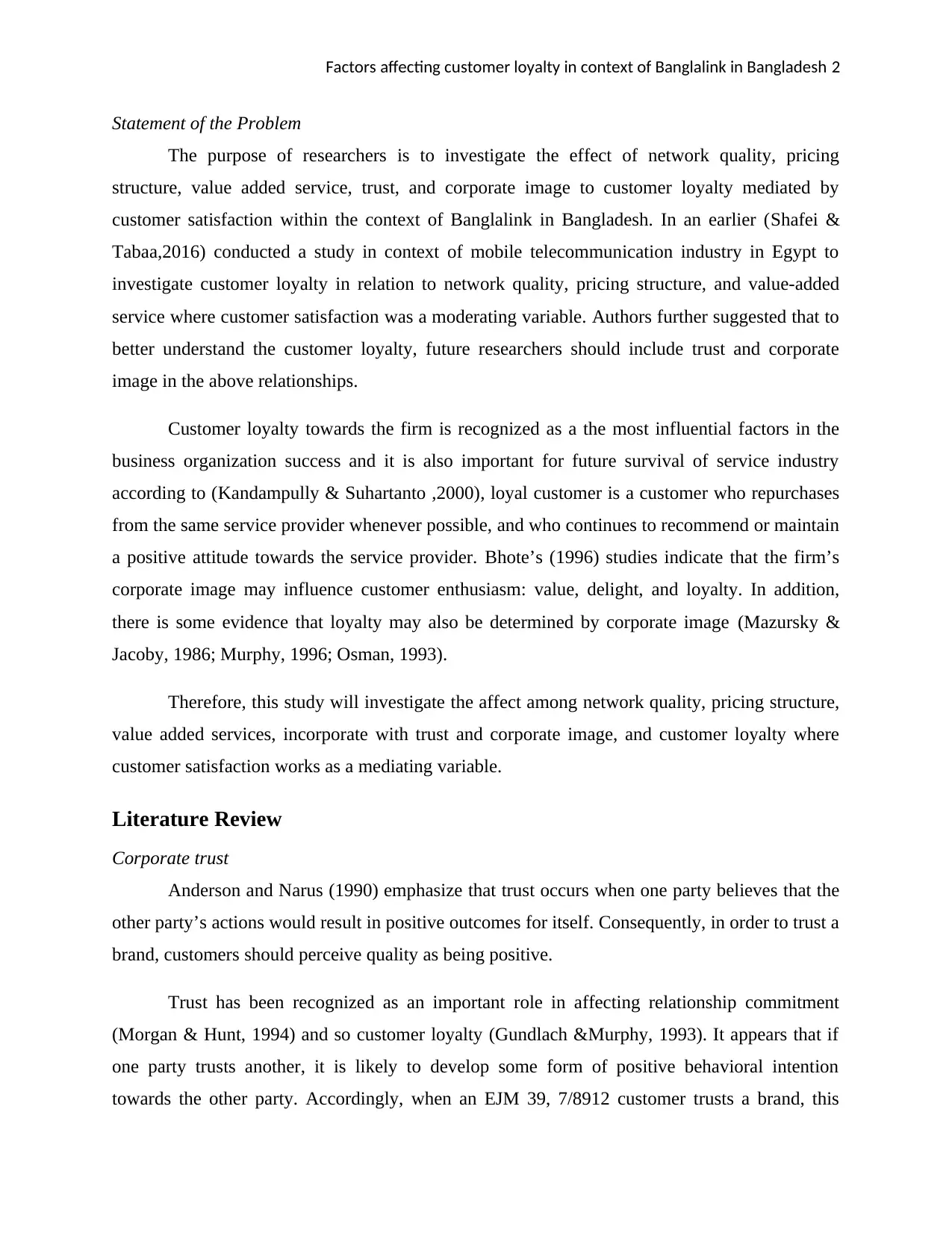
Factors affecting customer loyalty in context of Banglalink in Bangladesh 2
Statement of the Problem
The purpose of researchers is to investigate the effect of network quality, pricing
structure, value added service, trust, and corporate image to customer loyalty mediated by
customer satisfaction within the context of Banglalink in Bangladesh. In an earlier (Shafei &
Tabaa,2016) conducted a study in context of mobile telecommunication industry in Egypt to
investigate customer loyalty in relation to network quality, pricing structure, and value-added
service where customer satisfaction was a moderating variable. Authors further suggested that to
better understand the customer loyalty, future researchers should include trust and corporate
image in the above relationships.
Customer loyalty towards the firm is recognized as a the most influential factors in the
business organization success and it is also important for future survival of service industry
according to (Kandampully & Suhartanto ,2000), loyal customer is a customer who repurchases
from the same service provider whenever possible, and who continues to recommend or maintain
a positive attitude towards the service provider. Bhote’s (1996) studies indicate that the firm’s
corporate image may influence customer enthusiasm: value, delight, and loyalty. In addition,
there is some evidence that loyalty may also be determined by corporate image (Mazursky &
Jacoby, 1986; Murphy, 1996; Osman, 1993).
Therefore, this study will investigate the affect among network quality, pricing structure,
value added services, incorporate with trust and corporate image, and customer loyalty where
customer satisfaction works as a mediating variable.
Literature Review
Corporate trust
Anderson and Narus (1990) emphasize that trust occurs when one party believes that the
other party’s actions would result in positive outcomes for itself. Consequently, in order to trust a
brand, customers should perceive quality as being positive.
Trust has been recognized as an important role in affecting relationship commitment
(Morgan & Hunt, 1994) and so customer loyalty (Gundlach &Murphy, 1993). It appears that if
one party trusts another, it is likely to develop some form of positive behavioral intention
towards the other party. Accordingly, when an EJM 39, 7/8912 customer trusts a brand, this
Statement of the Problem
The purpose of researchers is to investigate the effect of network quality, pricing
structure, value added service, trust, and corporate image to customer loyalty mediated by
customer satisfaction within the context of Banglalink in Bangladesh. In an earlier (Shafei &
Tabaa,2016) conducted a study in context of mobile telecommunication industry in Egypt to
investigate customer loyalty in relation to network quality, pricing structure, and value-added
service where customer satisfaction was a moderating variable. Authors further suggested that to
better understand the customer loyalty, future researchers should include trust and corporate
image in the above relationships.
Customer loyalty towards the firm is recognized as a the most influential factors in the
business organization success and it is also important for future survival of service industry
according to (Kandampully & Suhartanto ,2000), loyal customer is a customer who repurchases
from the same service provider whenever possible, and who continues to recommend or maintain
a positive attitude towards the service provider. Bhote’s (1996) studies indicate that the firm’s
corporate image may influence customer enthusiasm: value, delight, and loyalty. In addition,
there is some evidence that loyalty may also be determined by corporate image (Mazursky &
Jacoby, 1986; Murphy, 1996; Osman, 1993).
Therefore, this study will investigate the affect among network quality, pricing structure,
value added services, incorporate with trust and corporate image, and customer loyalty where
customer satisfaction works as a mediating variable.
Literature Review
Corporate trust
Anderson and Narus (1990) emphasize that trust occurs when one party believes that the
other party’s actions would result in positive outcomes for itself. Consequently, in order to trust a
brand, customers should perceive quality as being positive.
Trust has been recognized as an important role in affecting relationship commitment
(Morgan & Hunt, 1994) and so customer loyalty (Gundlach &Murphy, 1993). It appears that if
one party trusts another, it is likely to develop some form of positive behavioral intention
towards the other party. Accordingly, when an EJM 39, 7/8912 customer trusts a brand, this
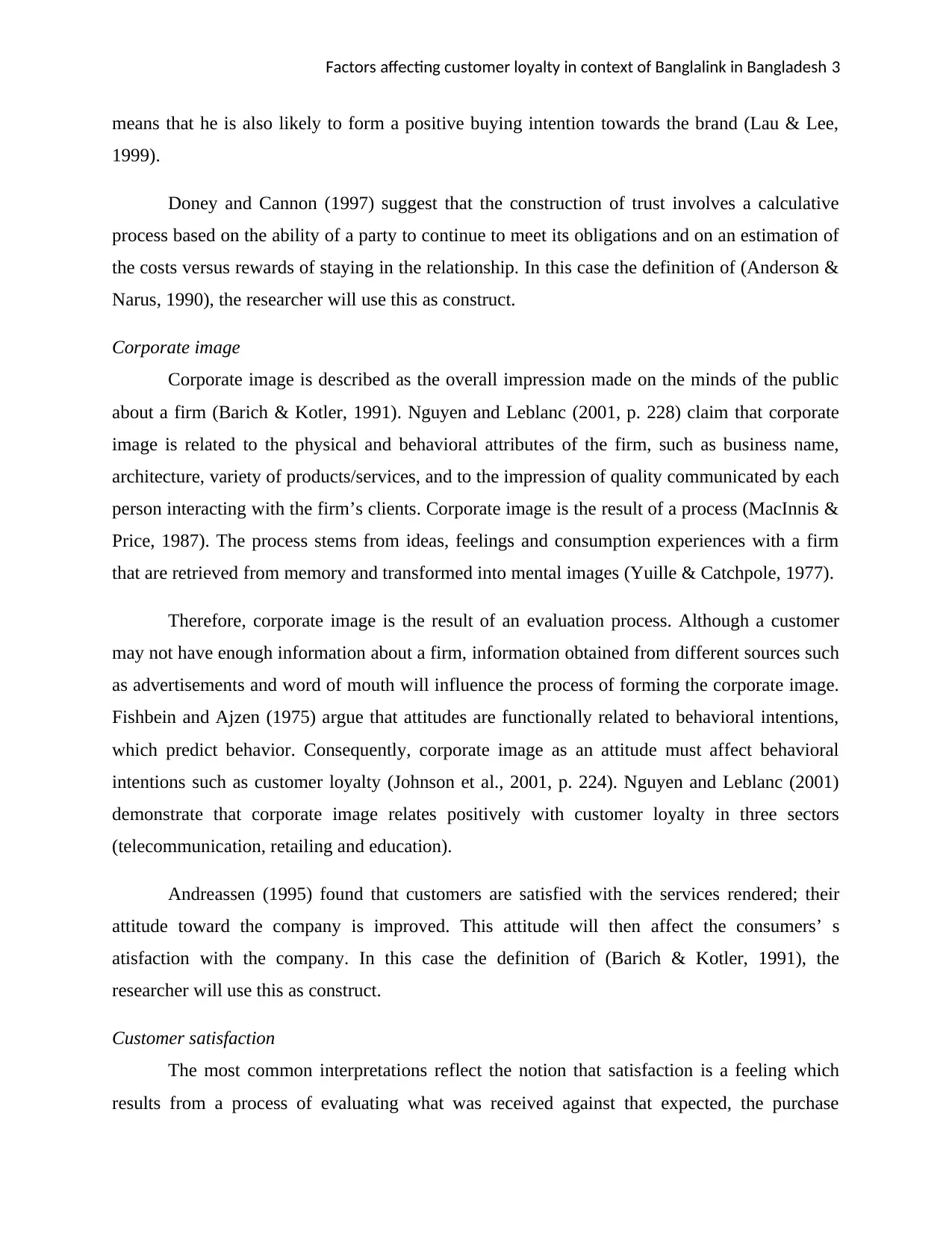
Factors affecting customer loyalty in context of Banglalink in Bangladesh 3
means that he is also likely to form a positive buying intention towards the brand (Lau & Lee,
1999).
Doney and Cannon (1997) suggest that the construction of trust involves a calculative
process based on the ability of a party to continue to meet its obligations and on an estimation of
the costs versus rewards of staying in the relationship. In this case the definition of (Anderson &
Narus, 1990), the researcher will use this as construct.
Corporate image
Corporate image is described as the overall impression made on the minds of the public
about a firm (Barich & Kotler, 1991). Nguyen and Leblanc (2001, p. 228) claim that corporate
image is related to the physical and behavioral attributes of the firm, such as business name,
architecture, variety of products/services, and to the impression of quality communicated by each
person interacting with the firm’s clients. Corporate image is the result of a process (MacInnis &
Price, 1987). The process stems from ideas, feelings and consumption experiences with a firm
that are retrieved from memory and transformed into mental images (Yuille & Catchpole, 1977).
Therefore, corporate image is the result of an evaluation process. Although a customer
may not have enough information about a firm, information obtained from different sources such
as advertisements and word of mouth will influence the process of forming the corporate image.
Fishbein and Ajzen (1975) argue that attitudes are functionally related to behavioral intentions,
which predict behavior. Consequently, corporate image as an attitude must affect behavioral
intentions such as customer loyalty (Johnson et al., 2001, p. 224). Nguyen and Leblanc (2001)
demonstrate that corporate image relates positively with customer loyalty in three sectors
(telecommunication, retailing and education).
Andreassen (1995) found that customers are satisfied with the services rendered; their
attitude toward the company is improved. This attitude will then affect the consumers’ s
atisfaction with the company. In this case the definition of (Barich & Kotler, 1991), the
researcher will use this as construct.
Customer satisfaction
The most common interpretations reflect the notion that satisfaction is a feeling which
results from a process of evaluating what was received against that expected, the purchase
means that he is also likely to form a positive buying intention towards the brand (Lau & Lee,
1999).
Doney and Cannon (1997) suggest that the construction of trust involves a calculative
process based on the ability of a party to continue to meet its obligations and on an estimation of
the costs versus rewards of staying in the relationship. In this case the definition of (Anderson &
Narus, 1990), the researcher will use this as construct.
Corporate image
Corporate image is described as the overall impression made on the minds of the public
about a firm (Barich & Kotler, 1991). Nguyen and Leblanc (2001, p. 228) claim that corporate
image is related to the physical and behavioral attributes of the firm, such as business name,
architecture, variety of products/services, and to the impression of quality communicated by each
person interacting with the firm’s clients. Corporate image is the result of a process (MacInnis &
Price, 1987). The process stems from ideas, feelings and consumption experiences with a firm
that are retrieved from memory and transformed into mental images (Yuille & Catchpole, 1977).
Therefore, corporate image is the result of an evaluation process. Although a customer
may not have enough information about a firm, information obtained from different sources such
as advertisements and word of mouth will influence the process of forming the corporate image.
Fishbein and Ajzen (1975) argue that attitudes are functionally related to behavioral intentions,
which predict behavior. Consequently, corporate image as an attitude must affect behavioral
intentions such as customer loyalty (Johnson et al., 2001, p. 224). Nguyen and Leblanc (2001)
demonstrate that corporate image relates positively with customer loyalty in three sectors
(telecommunication, retailing and education).
Andreassen (1995) found that customers are satisfied with the services rendered; their
attitude toward the company is improved. This attitude will then affect the consumers’ s
atisfaction with the company. In this case the definition of (Barich & Kotler, 1991), the
researcher will use this as construct.
Customer satisfaction
The most common interpretations reflect the notion that satisfaction is a feeling which
results from a process of evaluating what was received against that expected, the purchase
Secure Best Marks with AI Grader
Need help grading? Try our AI Grader for instant feedback on your assignments.
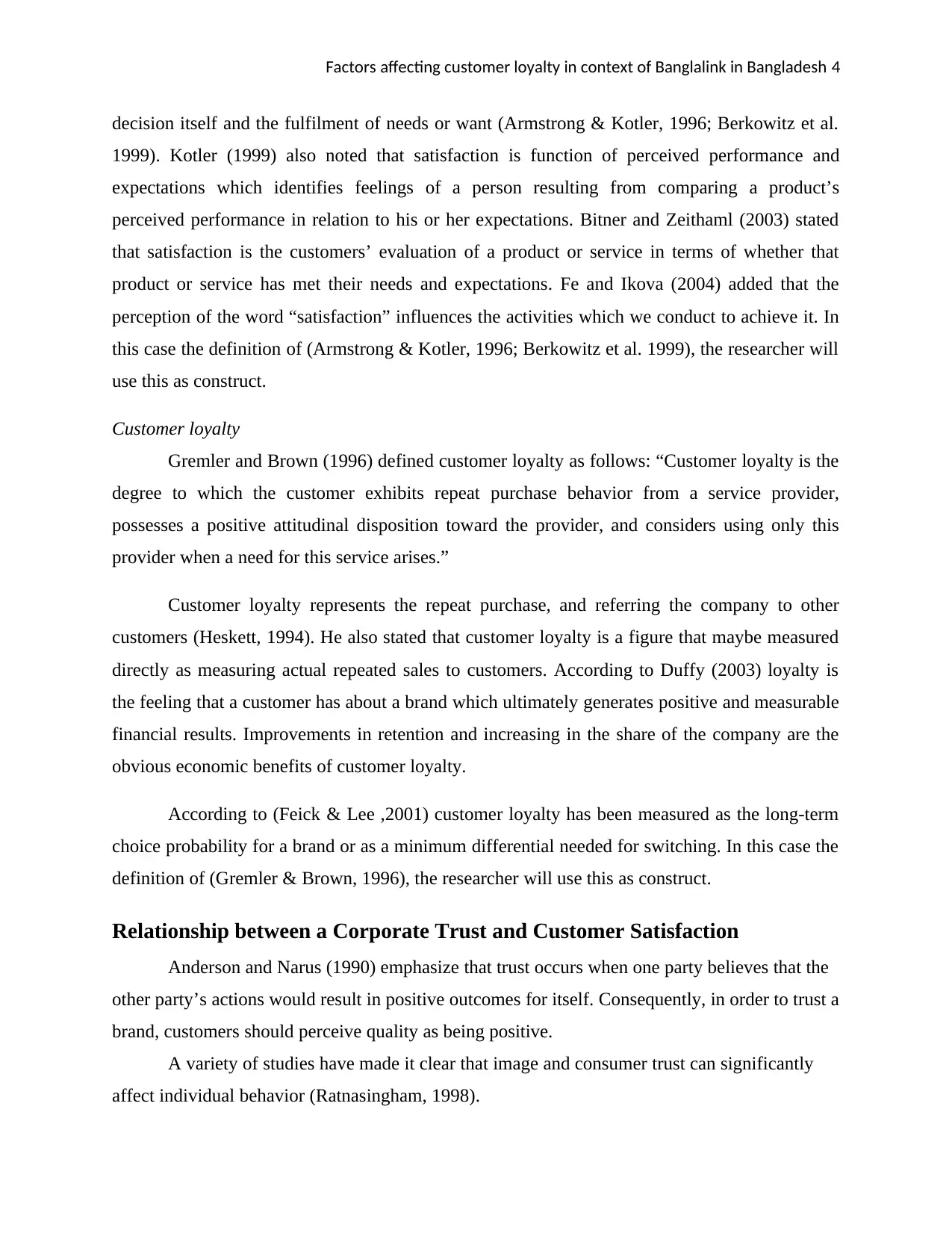
Factors affecting customer loyalty in context of Banglalink in Bangladesh 4
decision itself and the fulfilment of needs or want (Armstrong & Kotler, 1996; Berkowitz et al.
1999). Kotler (1999) also noted that satisfaction is function of perceived performance and
expectations which identifies feelings of a person resulting from comparing a product’s
perceived performance in relation to his or her expectations. Bitner and Zeithaml (2003) stated
that satisfaction is the customers’ evaluation of a product or service in terms of whether that
product or service has met their needs and expectations. Fe and Ikova (2004) added that the
perception of the word “satisfaction” influences the activities which we conduct to achieve it. In
this case the definition of (Armstrong & Kotler, 1996; Berkowitz et al. 1999), the researcher will
use this as construct.
Customer loyalty
Gremler and Brown (1996) defined customer loyalty as follows: “Customer loyalty is the
degree to which the customer exhibits repeat purchase behavior from a service provider,
possesses a positive attitudinal disposition toward the provider, and considers using only this
provider when a need for this service arises.”
Customer loyalty represents the repeat purchase, and referring the company to other
customers (Heskett, 1994). He also stated that customer loyalty is a figure that maybe measured
directly as measuring actual repeated sales to customers. According to Duffy (2003) loyalty is
the feeling that a customer has about a brand which ultimately generates positive and measurable
financial results. Improvements in retention and increasing in the share of the company are the
obvious economic benefits of customer loyalty.
According to (Feick & Lee ,2001) customer loyalty has been measured as the long-term
choice probability for a brand or as a minimum differential needed for switching. In this case the
definition of (Gremler & Brown, 1996), the researcher will use this as construct.
Relationship between a Corporate Trust and Customer Satisfaction
Anderson and Narus (1990) emphasize that trust occurs when one party believes that the
other party’s actions would result in positive outcomes for itself. Consequently, in order to trust a
brand, customers should perceive quality as being positive.
A variety of studies have made it clear that image and consumer trust can significantly
affect individual behavior (Ratnasingham, 1998).
decision itself and the fulfilment of needs or want (Armstrong & Kotler, 1996; Berkowitz et al.
1999). Kotler (1999) also noted that satisfaction is function of perceived performance and
expectations which identifies feelings of a person resulting from comparing a product’s
perceived performance in relation to his or her expectations. Bitner and Zeithaml (2003) stated
that satisfaction is the customers’ evaluation of a product or service in terms of whether that
product or service has met their needs and expectations. Fe and Ikova (2004) added that the
perception of the word “satisfaction” influences the activities which we conduct to achieve it. In
this case the definition of (Armstrong & Kotler, 1996; Berkowitz et al. 1999), the researcher will
use this as construct.
Customer loyalty
Gremler and Brown (1996) defined customer loyalty as follows: “Customer loyalty is the
degree to which the customer exhibits repeat purchase behavior from a service provider,
possesses a positive attitudinal disposition toward the provider, and considers using only this
provider when a need for this service arises.”
Customer loyalty represents the repeat purchase, and referring the company to other
customers (Heskett, 1994). He also stated that customer loyalty is a figure that maybe measured
directly as measuring actual repeated sales to customers. According to Duffy (2003) loyalty is
the feeling that a customer has about a brand which ultimately generates positive and measurable
financial results. Improvements in retention and increasing in the share of the company are the
obvious economic benefits of customer loyalty.
According to (Feick & Lee ,2001) customer loyalty has been measured as the long-term
choice probability for a brand or as a minimum differential needed for switching. In this case the
definition of (Gremler & Brown, 1996), the researcher will use this as construct.
Relationship between a Corporate Trust and Customer Satisfaction
Anderson and Narus (1990) emphasize that trust occurs when one party believes that the
other party’s actions would result in positive outcomes for itself. Consequently, in order to trust a
brand, customers should perceive quality as being positive.
A variety of studies have made it clear that image and consumer trust can significantly
affect individual behavior (Ratnasingham, 1998).
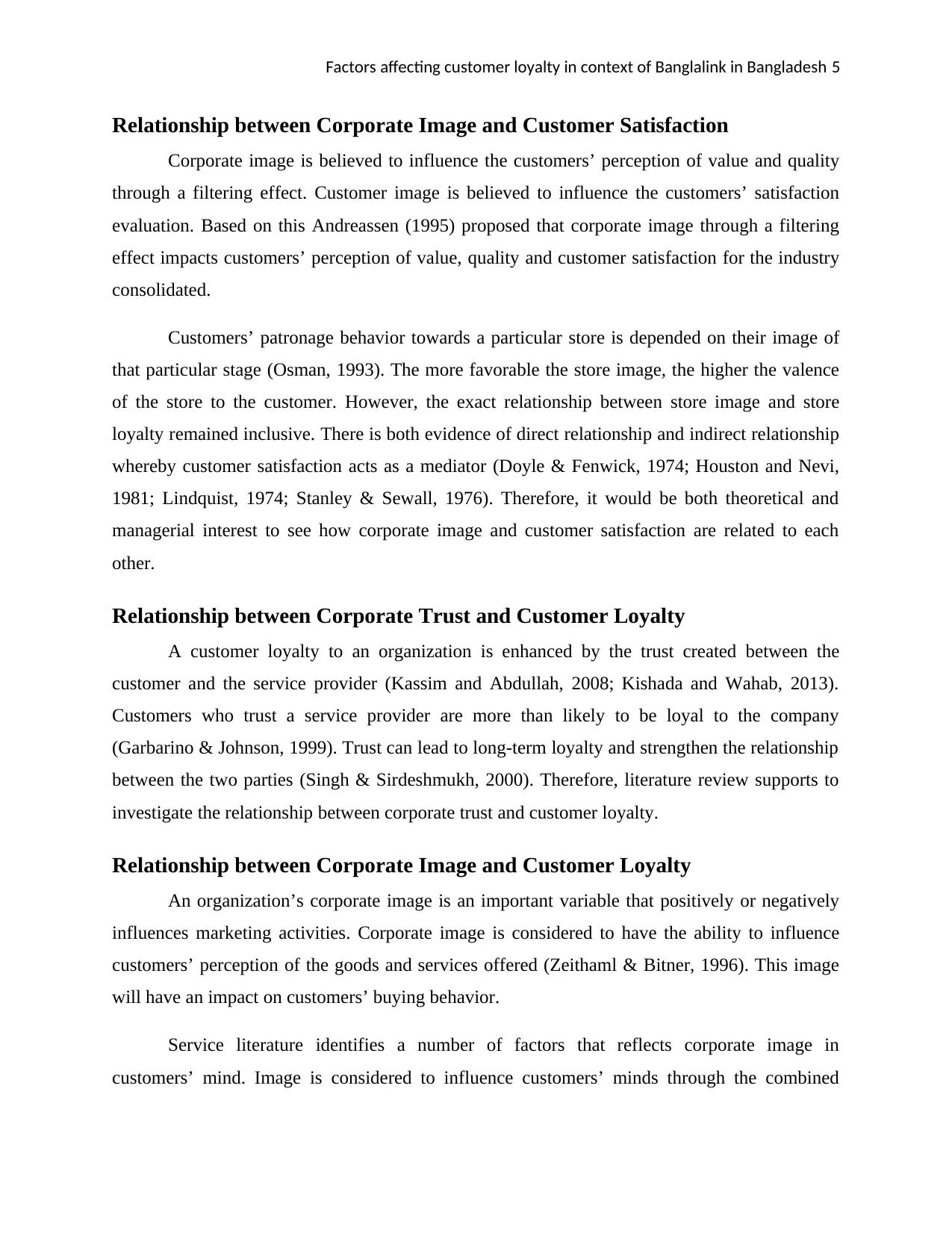
Factors affecting customer loyalty in context of Banglalink in Bangladesh 5
Relationship between Corporate Image and Customer Satisfaction
Corporate image is believed to influence the customers’ perception of value and quality
through a filtering effect. Customer image is believed to influence the customers’ satisfaction
evaluation. Based on this Andreassen (1995) proposed that corporate image through a filtering
effect impacts customers’ perception of value, quality and customer satisfaction for the industry
consolidated.
Customers’ patronage behavior towards a particular store is depended on their image of
that particular stage (Osman, 1993). The more favorable the store image, the higher the valence
of the store to the customer. However, the exact relationship between store image and store
loyalty remained inclusive. There is both evidence of direct relationship and indirect relationship
whereby customer satisfaction acts as a mediator (Doyle & Fenwick, 1974; Houston and Nevi,
1981; Lindquist, 1974; Stanley & Sewall, 1976). Therefore, it would be both theoretical and
managerial interest to see how corporate image and customer satisfaction are related to each
other.
Relationship between Corporate Trust and Customer Loyalty
A customer loyalty to an organization is enhanced by the trust created between the
customer and the service provider (Kassim and Abdullah, 2008; Kishada and Wahab, 2013).
Customers who trust a service provider are more than likely to be loyal to the company
(Garbarino & Johnson, 1999). Trust can lead to long-term loyalty and strengthen the relationship
between the two parties (Singh & Sirdeshmukh, 2000). Therefore, literature review supports to
investigate the relationship between corporate trust and customer loyalty.
Relationship between Corporate Image and Customer Loyalty
An organization’s corporate image is an important variable that positively or negatively
influences marketing activities. Corporate image is considered to have the ability to influence
customers’ perception of the goods and services offered (Zeithaml & Bitner, 1996). This image
will have an impact on customers’ buying behavior.
Service literature identifies a number of factors that reflects corporate image in
customers’ mind. Image is considered to influence customers’ minds through the combined
Relationship between Corporate Image and Customer Satisfaction
Corporate image is believed to influence the customers’ perception of value and quality
through a filtering effect. Customer image is believed to influence the customers’ satisfaction
evaluation. Based on this Andreassen (1995) proposed that corporate image through a filtering
effect impacts customers’ perception of value, quality and customer satisfaction for the industry
consolidated.
Customers’ patronage behavior towards a particular store is depended on their image of
that particular stage (Osman, 1993). The more favorable the store image, the higher the valence
of the store to the customer. However, the exact relationship between store image and store
loyalty remained inclusive. There is both evidence of direct relationship and indirect relationship
whereby customer satisfaction acts as a mediator (Doyle & Fenwick, 1974; Houston and Nevi,
1981; Lindquist, 1974; Stanley & Sewall, 1976). Therefore, it would be both theoretical and
managerial interest to see how corporate image and customer satisfaction are related to each
other.
Relationship between Corporate Trust and Customer Loyalty
A customer loyalty to an organization is enhanced by the trust created between the
customer and the service provider (Kassim and Abdullah, 2008; Kishada and Wahab, 2013).
Customers who trust a service provider are more than likely to be loyal to the company
(Garbarino & Johnson, 1999). Trust can lead to long-term loyalty and strengthen the relationship
between the two parties (Singh & Sirdeshmukh, 2000). Therefore, literature review supports to
investigate the relationship between corporate trust and customer loyalty.
Relationship between Corporate Image and Customer Loyalty
An organization’s corporate image is an important variable that positively or negatively
influences marketing activities. Corporate image is considered to have the ability to influence
customers’ perception of the goods and services offered (Zeithaml & Bitner, 1996). This image
will have an impact on customers’ buying behavior.
Service literature identifies a number of factors that reflects corporate image in
customers’ mind. Image is considered to influence customers’ minds through the combined
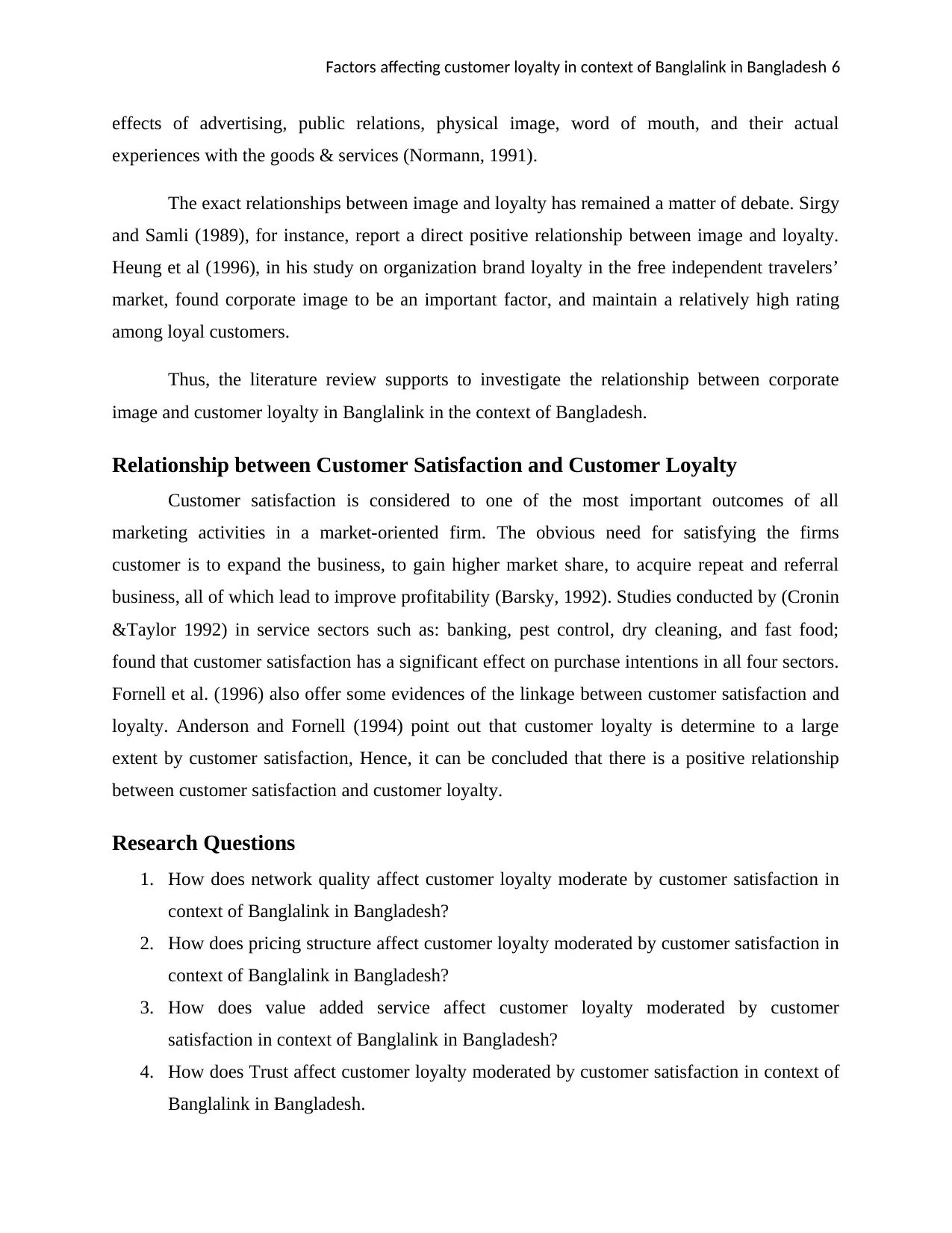
Factors affecting customer loyalty in context of Banglalink in Bangladesh 6
effects of advertising, public relations, physical image, word of mouth, and their actual
experiences with the goods & services (Normann, 1991).
The exact relationships between image and loyalty has remained a matter of debate. Sirgy
and Samli (1989), for instance, report a direct positive relationship between image and loyalty.
Heung et al (1996), in his study on organization brand loyalty in the free independent travelers’
market, found corporate image to be an important factor, and maintain a relatively high rating
among loyal customers.
Thus, the literature review supports to investigate the relationship between corporate
image and customer loyalty in Banglalink in the context of Bangladesh.
Relationship between Customer Satisfaction and Customer Loyalty
Customer satisfaction is considered to one of the most important outcomes of all
marketing activities in a market-oriented firm. The obvious need for satisfying the firms
customer is to expand the business, to gain higher market share, to acquire repeat and referral
business, all of which lead to improve profitability (Barsky, 1992). Studies conducted by (Cronin
&Taylor 1992) in service sectors such as: banking, pest control, dry cleaning, and fast food;
found that customer satisfaction has a significant effect on purchase intentions in all four sectors.
Fornell et al. (1996) also offer some evidences of the linkage between customer satisfaction and
loyalty. Anderson and Fornell (1994) point out that customer loyalty is determine to a large
extent by customer satisfaction, Hence, it can be concluded that there is a positive relationship
between customer satisfaction and customer loyalty.
Research Questions
1. How does network quality affect customer loyalty moderate by customer satisfaction in
context of Banglalink in Bangladesh?
2. How does pricing structure affect customer loyalty moderated by customer satisfaction in
context of Banglalink in Bangladesh?
3. How does value added service affect customer loyalty moderated by customer
satisfaction in context of Banglalink in Bangladesh?
4. How does Trust affect customer loyalty moderated by customer satisfaction in context of
Banglalink in Bangladesh.
effects of advertising, public relations, physical image, word of mouth, and their actual
experiences with the goods & services (Normann, 1991).
The exact relationships between image and loyalty has remained a matter of debate. Sirgy
and Samli (1989), for instance, report a direct positive relationship between image and loyalty.
Heung et al (1996), in his study on organization brand loyalty in the free independent travelers’
market, found corporate image to be an important factor, and maintain a relatively high rating
among loyal customers.
Thus, the literature review supports to investigate the relationship between corporate
image and customer loyalty in Banglalink in the context of Bangladesh.
Relationship between Customer Satisfaction and Customer Loyalty
Customer satisfaction is considered to one of the most important outcomes of all
marketing activities in a market-oriented firm. The obvious need for satisfying the firms
customer is to expand the business, to gain higher market share, to acquire repeat and referral
business, all of which lead to improve profitability (Barsky, 1992). Studies conducted by (Cronin
&Taylor 1992) in service sectors such as: banking, pest control, dry cleaning, and fast food;
found that customer satisfaction has a significant effect on purchase intentions in all four sectors.
Fornell et al. (1996) also offer some evidences of the linkage between customer satisfaction and
loyalty. Anderson and Fornell (1994) point out that customer loyalty is determine to a large
extent by customer satisfaction, Hence, it can be concluded that there is a positive relationship
between customer satisfaction and customer loyalty.
Research Questions
1. How does network quality affect customer loyalty moderate by customer satisfaction in
context of Banglalink in Bangladesh?
2. How does pricing structure affect customer loyalty moderated by customer satisfaction in
context of Banglalink in Bangladesh?
3. How does value added service affect customer loyalty moderated by customer
satisfaction in context of Banglalink in Bangladesh?
4. How does Trust affect customer loyalty moderated by customer satisfaction in context of
Banglalink in Bangladesh.
Paraphrase This Document
Need a fresh take? Get an instant paraphrase of this document with our AI Paraphraser
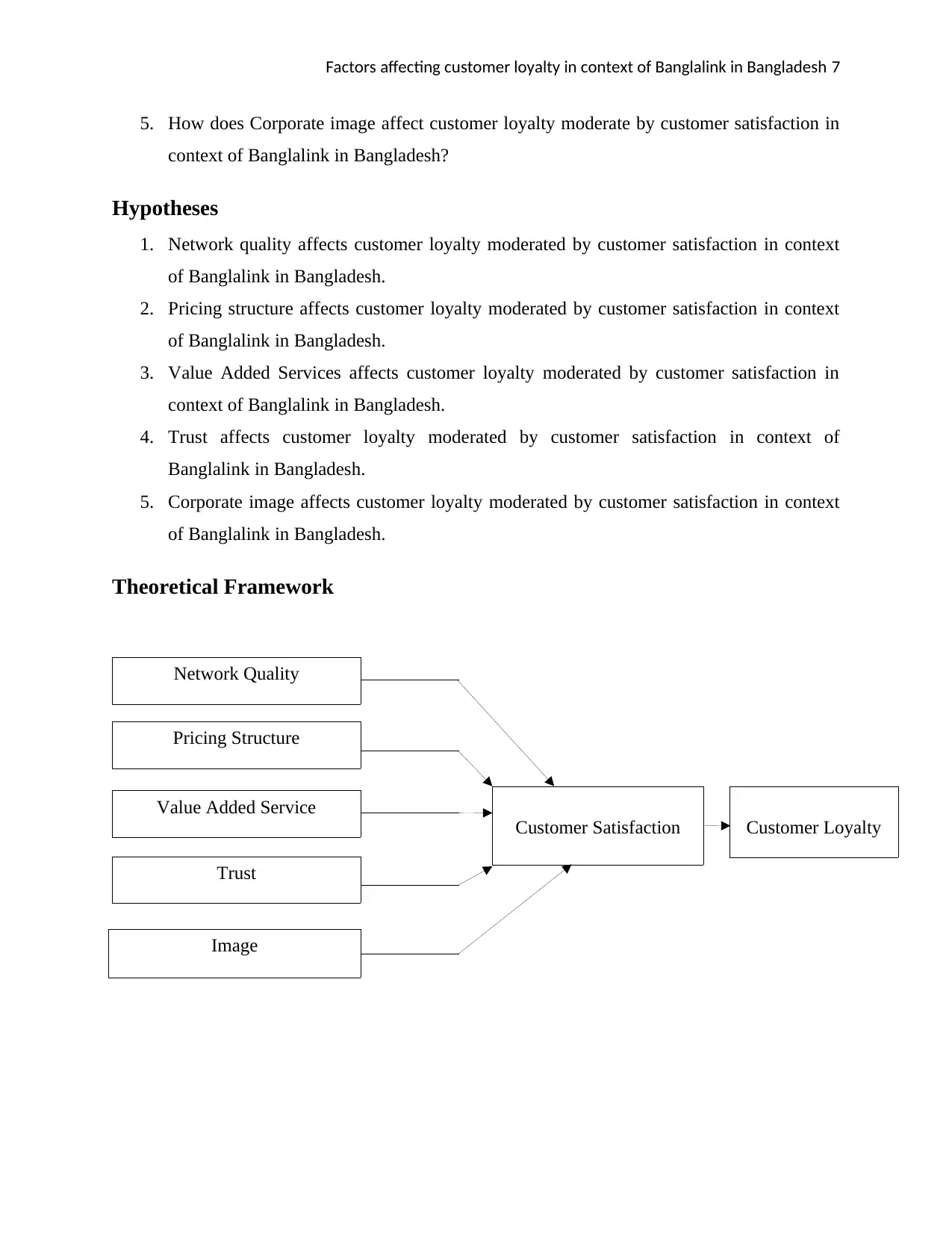
Factors affecting customer loyalty in context of Banglalink in Bangladesh 7
5. How does Corporate image affect customer loyalty moderate by customer satisfaction in
context of Banglalink in Bangladesh?
Hypotheses
1. Network quality affects customer loyalty moderated by customer satisfaction in context
of Banglalink in Bangladesh.
2. Pricing structure affects customer loyalty moderated by customer satisfaction in context
of Banglalink in Bangladesh.
3. Value Added Services affects customer loyalty moderated by customer satisfaction in
context of Banglalink in Bangladesh.
4. Trust affects customer loyalty moderated by customer satisfaction in context of
Banglalink in Bangladesh.
5. Corporate image affects customer loyalty moderated by customer satisfaction in context
of Banglalink in Bangladesh.
Theoretical Framework
Customer Satisfaction Customer Loyalty
Network Quality
Pricing Structure
Value Added Service
Trust
Image
5. How does Corporate image affect customer loyalty moderate by customer satisfaction in
context of Banglalink in Bangladesh?
Hypotheses
1. Network quality affects customer loyalty moderated by customer satisfaction in context
of Banglalink in Bangladesh.
2. Pricing structure affects customer loyalty moderated by customer satisfaction in context
of Banglalink in Bangladesh.
3. Value Added Services affects customer loyalty moderated by customer satisfaction in
context of Banglalink in Bangladesh.
4. Trust affects customer loyalty moderated by customer satisfaction in context of
Banglalink in Bangladesh.
5. Corporate image affects customer loyalty moderated by customer satisfaction in context
of Banglalink in Bangladesh.
Theoretical Framework
Customer Satisfaction Customer Loyalty
Network Quality
Pricing Structure
Value Added Service
Trust
Image
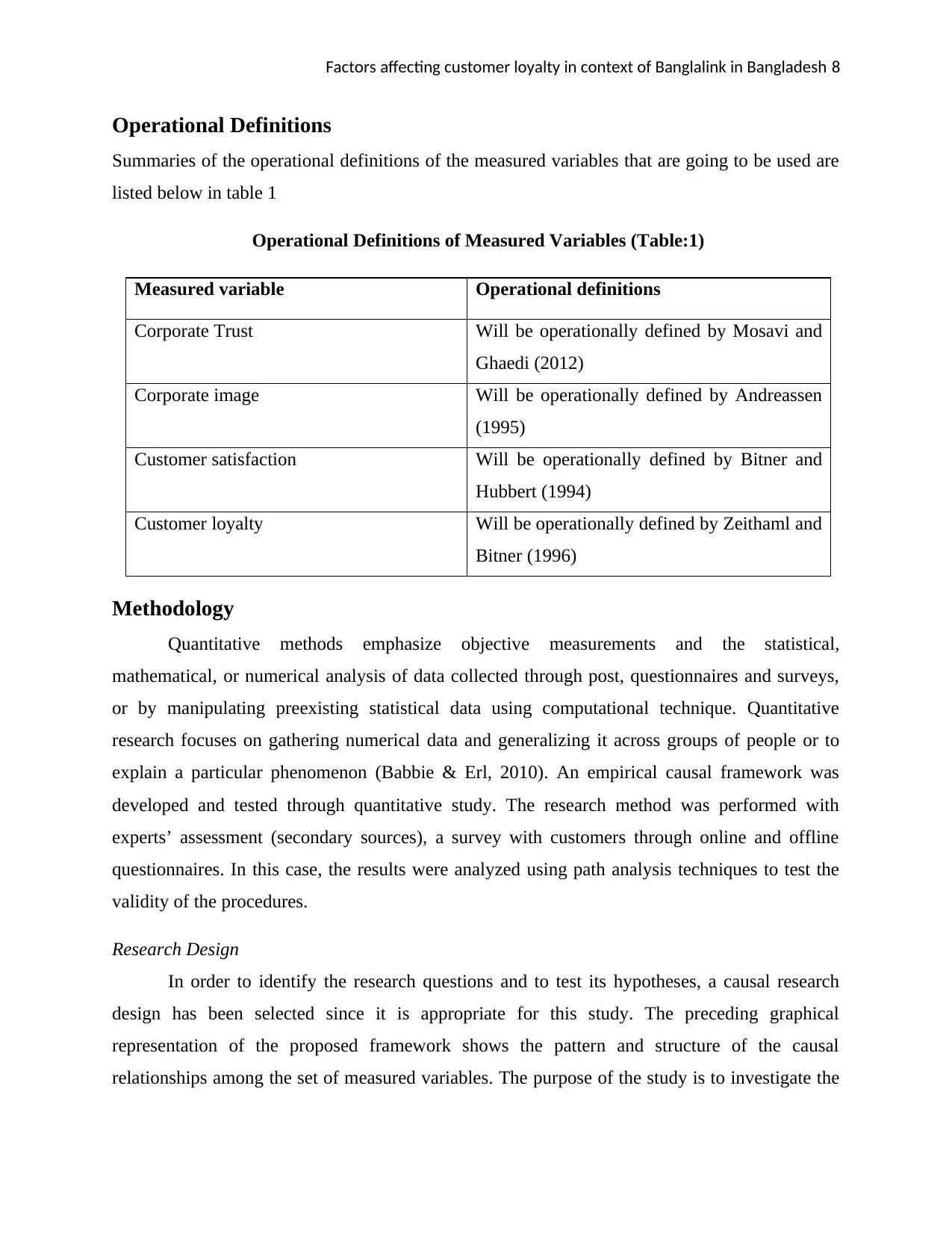
Factors affecting customer loyalty in context of Banglalink in Bangladesh 8
Operational Definitions
Summaries of the operational definitions of the measured variables that are going to be used are
listed below in table 1
Operational Definitions of Measured Variables (Table:1)
Measured variable Operational definitions
Corporate Trust Will be operationally defined by Mosavi and
Ghaedi (2012)
Corporate image Will be operationally defined by Andreassen
(1995)
Customer satisfaction Will be operationally defined by Bitner and
Hubbert (1994)
Customer loyalty Will be operationally defined by Zeithaml and
Bitner (1996)
Methodology
Quantitative methods emphasize objective measurements and the statistical,
mathematical, or numerical analysis of data collected through post, questionnaires and surveys,
or by manipulating preexisting statistical data using computational technique. Quantitative
research focuses on gathering numerical data and generalizing it across groups of people or to
explain a particular phenomenon (Babbie & Erl, 2010). An empirical causal framework was
developed and tested through quantitative study. The research method was performed with
experts’ assessment (secondary sources), a survey with customers through online and offline
questionnaires. In this case, the results were analyzed using path analysis techniques to test the
validity of the procedures.
Research Design
In order to identify the research questions and to test its hypotheses, a causal research
design has been selected since it is appropriate for this study. The preceding graphical
representation of the proposed framework shows the pattern and structure of the causal
relationships among the set of measured variables. The purpose of the study is to investigate the
Operational Definitions
Summaries of the operational definitions of the measured variables that are going to be used are
listed below in table 1
Operational Definitions of Measured Variables (Table:1)
Measured variable Operational definitions
Corporate Trust Will be operationally defined by Mosavi and
Ghaedi (2012)
Corporate image Will be operationally defined by Andreassen
(1995)
Customer satisfaction Will be operationally defined by Bitner and
Hubbert (1994)
Customer loyalty Will be operationally defined by Zeithaml and
Bitner (1996)
Methodology
Quantitative methods emphasize objective measurements and the statistical,
mathematical, or numerical analysis of data collected through post, questionnaires and surveys,
or by manipulating preexisting statistical data using computational technique. Quantitative
research focuses on gathering numerical data and generalizing it across groups of people or to
explain a particular phenomenon (Babbie & Erl, 2010). An empirical causal framework was
developed and tested through quantitative study. The research method was performed with
experts’ assessment (secondary sources), a survey with customers through online and offline
questionnaires. In this case, the results were analyzed using path analysis techniques to test the
validity of the procedures.
Research Design
In order to identify the research questions and to test its hypotheses, a causal research
design has been selected since it is appropriate for this study. The preceding graphical
representation of the proposed framework shows the pattern and structure of the causal
relationships among the set of measured variables. The purpose of the study is to investigate the
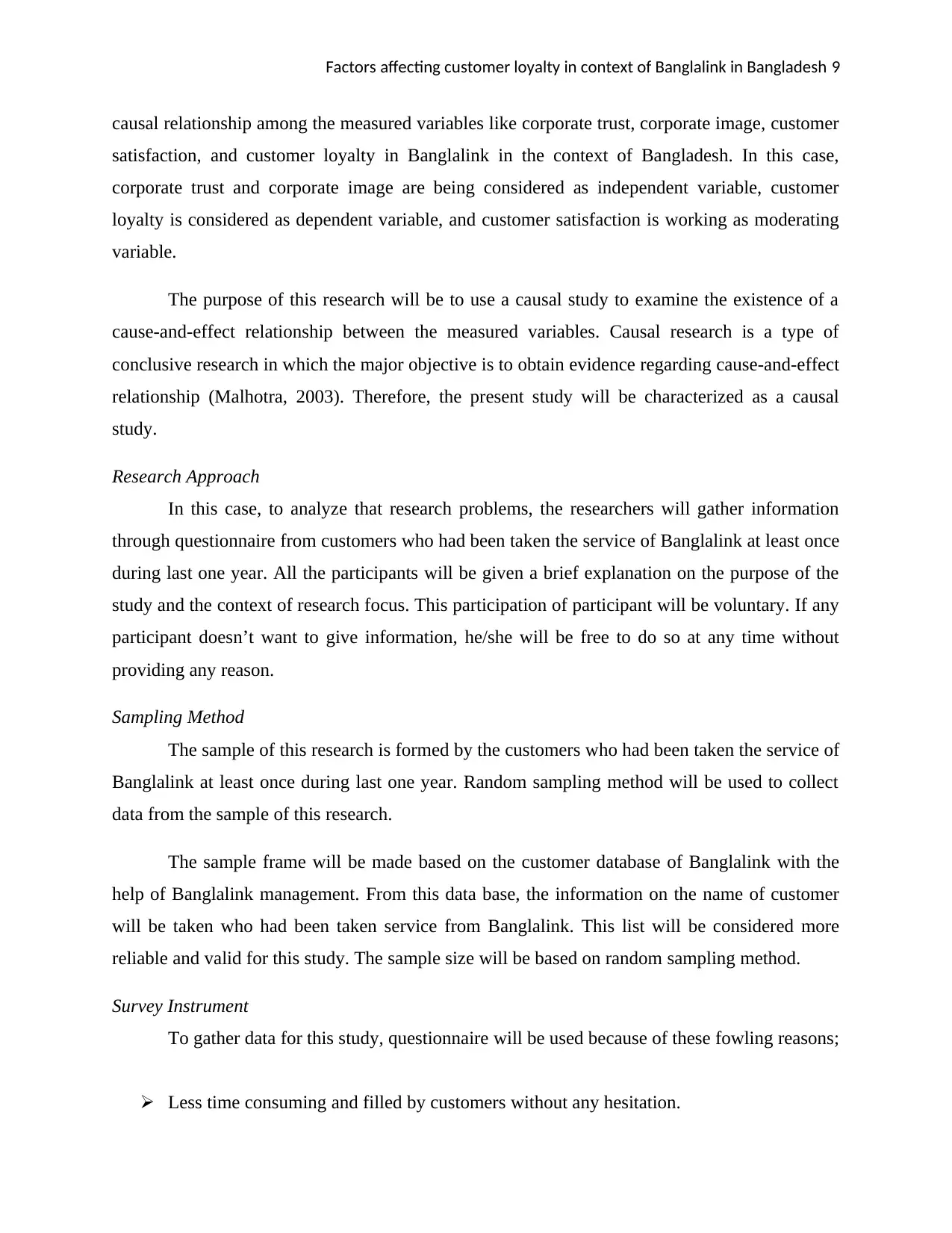
Factors affecting customer loyalty in context of Banglalink in Bangladesh 9
causal relationship among the measured variables like corporate trust, corporate image, customer
satisfaction, and customer loyalty in Banglalink in the context of Bangladesh. In this case,
corporate trust and corporate image are being considered as independent variable, customer
loyalty is considered as dependent variable, and customer satisfaction is working as moderating
variable.
The purpose of this research will be to use a causal study to examine the existence of a
cause-and-effect relationship between the measured variables. Causal research is a type of
conclusive research in which the major objective is to obtain evidence regarding cause-and-effect
relationship (Malhotra, 2003). Therefore, the present study will be characterized as a causal
study.
Research Approach
In this case, to analyze that research problems, the researchers will gather information
through questionnaire from customers who had been taken the service of Banglalink at least once
during last one year. All the participants will be given a brief explanation on the purpose of the
study and the context of research focus. This participation of participant will be voluntary. If any
participant doesn’t want to give information, he/she will be free to do so at any time without
providing any reason.
Sampling Method
The sample of this research is formed by the customers who had been taken the service of
Banglalink at least once during last one year. Random sampling method will be used to collect
data from the sample of this research.
The sample frame will be made based on the customer database of Banglalink with the
help of Banglalink management. From this data base, the information on the name of customer
will be taken who had been taken service from Banglalink. This list will be considered more
reliable and valid for this study. The sample size will be based on random sampling method.
Survey Instrument
To gather data for this study, questionnaire will be used because of these fowling reasons;
Less time consuming and filled by customers without any hesitation.
causal relationship among the measured variables like corporate trust, corporate image, customer
satisfaction, and customer loyalty in Banglalink in the context of Bangladesh. In this case,
corporate trust and corporate image are being considered as independent variable, customer
loyalty is considered as dependent variable, and customer satisfaction is working as moderating
variable.
The purpose of this research will be to use a causal study to examine the existence of a
cause-and-effect relationship between the measured variables. Causal research is a type of
conclusive research in which the major objective is to obtain evidence regarding cause-and-effect
relationship (Malhotra, 2003). Therefore, the present study will be characterized as a causal
study.
Research Approach
In this case, to analyze that research problems, the researchers will gather information
through questionnaire from customers who had been taken the service of Banglalink at least once
during last one year. All the participants will be given a brief explanation on the purpose of the
study and the context of research focus. This participation of participant will be voluntary. If any
participant doesn’t want to give information, he/she will be free to do so at any time without
providing any reason.
Sampling Method
The sample of this research is formed by the customers who had been taken the service of
Banglalink at least once during last one year. Random sampling method will be used to collect
data from the sample of this research.
The sample frame will be made based on the customer database of Banglalink with the
help of Banglalink management. From this data base, the information on the name of customer
will be taken who had been taken service from Banglalink. This list will be considered more
reliable and valid for this study. The sample size will be based on random sampling method.
Survey Instrument
To gather data for this study, questionnaire will be used because of these fowling reasons;
Less time consuming and filled by customers without any hesitation.
Secure Best Marks with AI Grader
Need help grading? Try our AI Grader for instant feedback on your assignments.
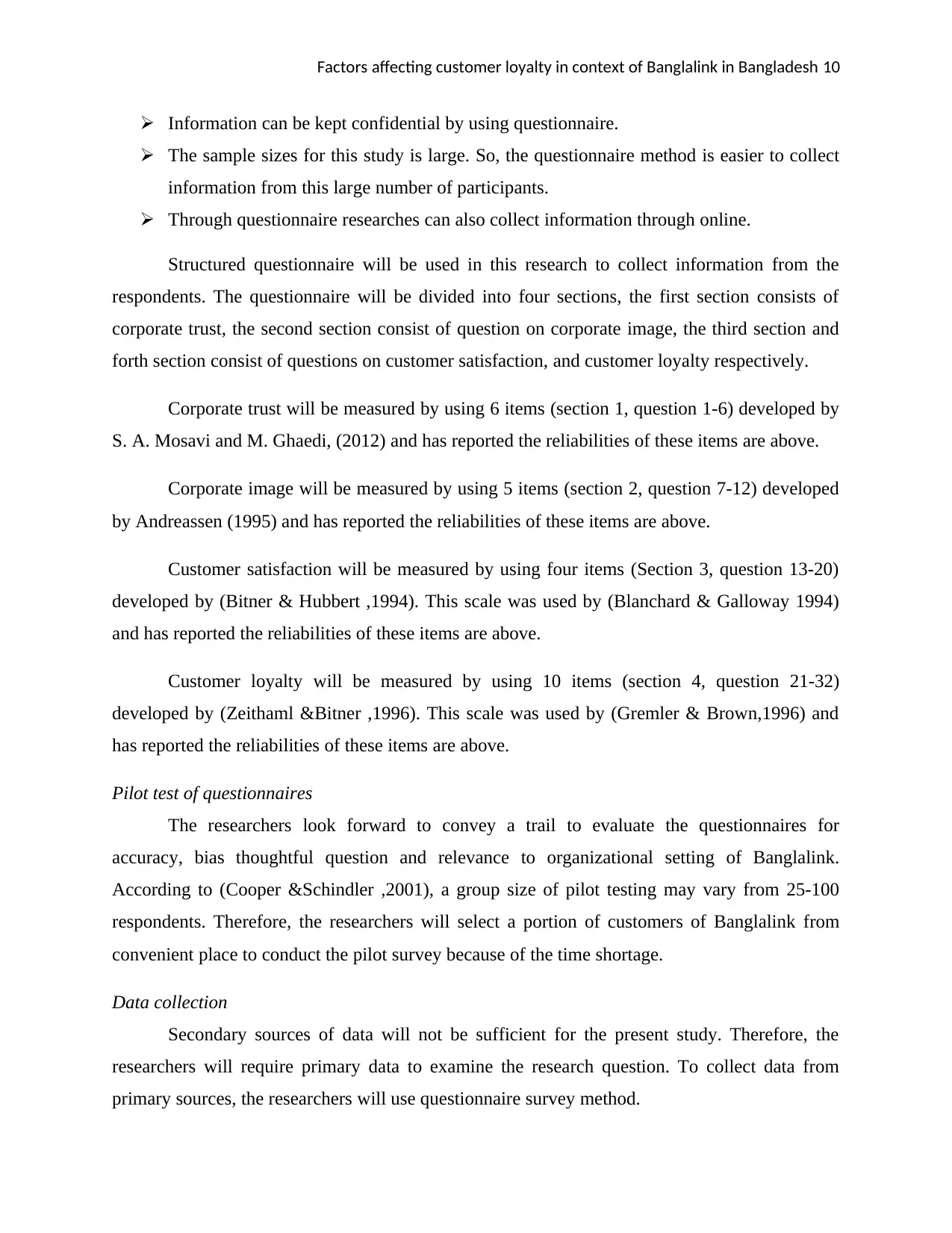
Factors affecting customer loyalty in context of Banglalink in Bangladesh 10
Information can be kept confidential by using questionnaire.
The sample sizes for this study is large. So, the questionnaire method is easier to collect
information from this large number of participants.
Through questionnaire researches can also collect information through online.
Structured questionnaire will be used in this research to collect information from the
respondents. The questionnaire will be divided into four sections, the first section consists of
corporate trust, the second section consist of question on corporate image, the third section and
forth section consist of questions on customer satisfaction, and customer loyalty respectively.
Corporate trust will be measured by using 6 items (section 1, question 1-6) developed by
S. A. Mosavi and M. Ghaedi, (2012) and has reported the reliabilities of these items are above.
Corporate image will be measured by using 5 items (section 2, question 7-12) developed
by Andreassen (1995) and has reported the reliabilities of these items are above.
Customer satisfaction will be measured by using four items (Section 3, question 13-20)
developed by (Bitner & Hubbert ,1994). This scale was used by (Blanchard & Galloway 1994)
and has reported the reliabilities of these items are above.
Customer loyalty will be measured by using 10 items (section 4, question 21-32)
developed by (Zeithaml &Bitner ,1996). This scale was used by (Gremler & Brown,1996) and
has reported the reliabilities of these items are above.
Pilot test of questionnaires
The researchers look forward to convey a trail to evaluate the questionnaires for
accuracy, bias thoughtful question and relevance to organizational setting of Banglalink.
According to (Cooper &Schindler ,2001), a group size of pilot testing may vary from 25-100
respondents. Therefore, the researchers will select a portion of customers of Banglalink from
convenient place to conduct the pilot survey because of the time shortage.
Data collection
Secondary sources of data will not be sufficient for the present study. Therefore, the
researchers will require primary data to examine the research question. To collect data from
primary sources, the researchers will use questionnaire survey method.
Information can be kept confidential by using questionnaire.
The sample sizes for this study is large. So, the questionnaire method is easier to collect
information from this large number of participants.
Through questionnaire researches can also collect information through online.
Structured questionnaire will be used in this research to collect information from the
respondents. The questionnaire will be divided into four sections, the first section consists of
corporate trust, the second section consist of question on corporate image, the third section and
forth section consist of questions on customer satisfaction, and customer loyalty respectively.
Corporate trust will be measured by using 6 items (section 1, question 1-6) developed by
S. A. Mosavi and M. Ghaedi, (2012) and has reported the reliabilities of these items are above.
Corporate image will be measured by using 5 items (section 2, question 7-12) developed
by Andreassen (1995) and has reported the reliabilities of these items are above.
Customer satisfaction will be measured by using four items (Section 3, question 13-20)
developed by (Bitner & Hubbert ,1994). This scale was used by (Blanchard & Galloway 1994)
and has reported the reliabilities of these items are above.
Customer loyalty will be measured by using 10 items (section 4, question 21-32)
developed by (Zeithaml &Bitner ,1996). This scale was used by (Gremler & Brown,1996) and
has reported the reliabilities of these items are above.
Pilot test of questionnaires
The researchers look forward to convey a trail to evaluate the questionnaires for
accuracy, bias thoughtful question and relevance to organizational setting of Banglalink.
According to (Cooper &Schindler ,2001), a group size of pilot testing may vary from 25-100
respondents. Therefore, the researchers will select a portion of customers of Banglalink from
convenient place to conduct the pilot survey because of the time shortage.
Data collection
Secondary sources of data will not be sufficient for the present study. Therefore, the
researchers will require primary data to examine the research question. To collect data from
primary sources, the researchers will use questionnaire survey method.
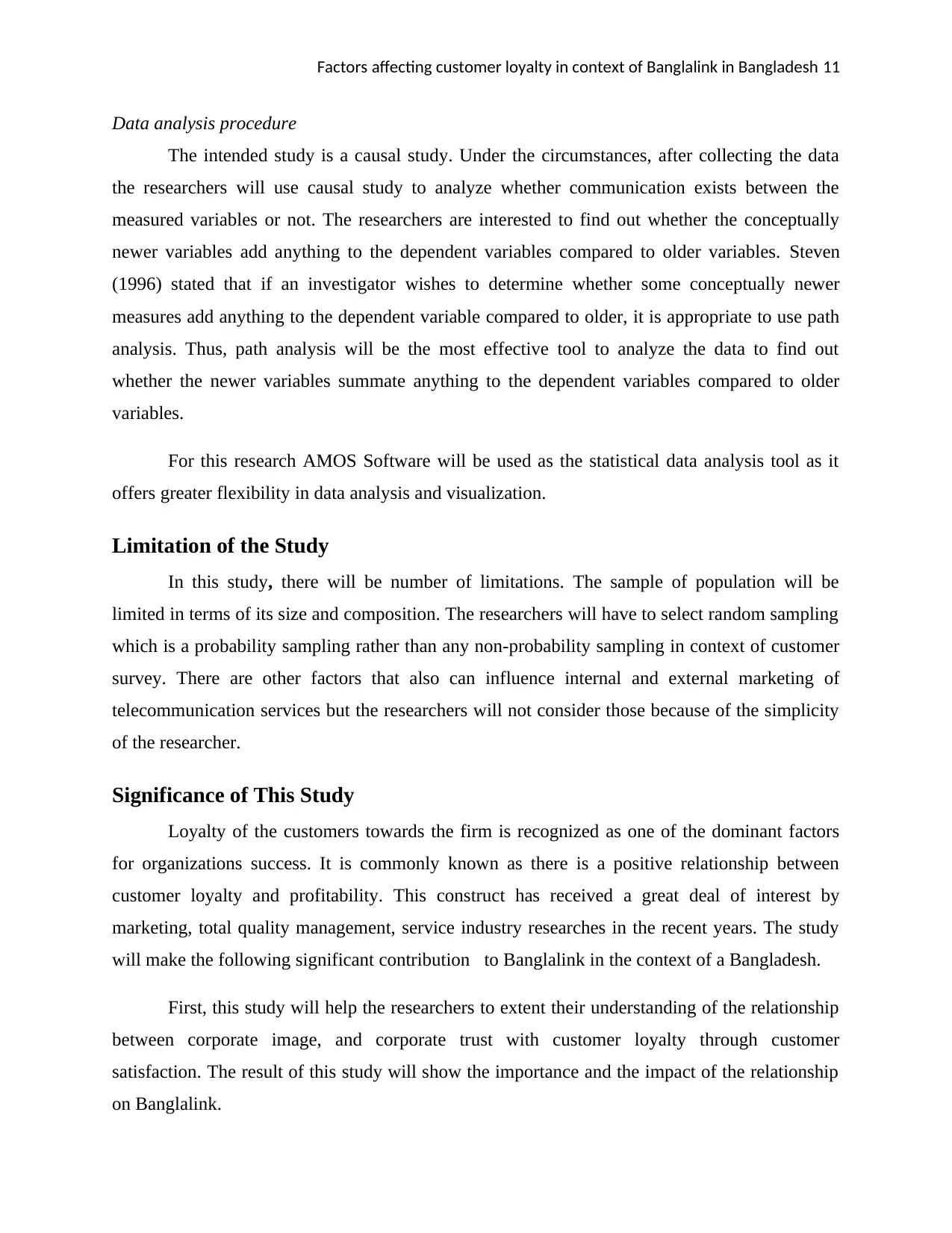
Factors affecting customer loyalty in context of Banglalink in Bangladesh 11
Data analysis procedure
The intended study is a causal study. Under the circumstances, after collecting the data
the researchers will use causal study to analyze whether communication exists between the
measured variables or not. The researchers are interested to find out whether the conceptually
newer variables add anything to the dependent variables compared to older variables. Steven
(1996) stated that if an investigator wishes to determine whether some conceptually newer
measures add anything to the dependent variable compared to older, it is appropriate to use path
analysis. Thus, path analysis will be the most effective tool to analyze the data to find out
whether the newer variables summate anything to the dependent variables compared to older
variables.
For this research AMOS Software will be used as the statistical data analysis tool as it
offers greater flexibility in data analysis and visualization.
Limitation of the Study
In this study, there will be number of limitations. The sample of population will be
limited in terms of its size and composition. The researchers will have to select random sampling
which is a probability sampling rather than any non-probability sampling in context of customer
survey. There are other factors that also can influence internal and external marketing of
telecommunication services but the researchers will not consider those because of the simplicity
of the researcher.
Significance of This Study
Loyalty of the customers towards the firm is recognized as one of the dominant factors
for organizations success. It is commonly known as there is a positive relationship between
customer loyalty and profitability. This construct has received a great deal of interest by
marketing, total quality management, service industry researches in the recent years. The study
will make the following significant contribution to Banglalink in the context of a Bangladesh.
First, this study will help the researchers to extent their understanding of the relationship
between corporate image, and corporate trust with customer loyalty through customer
satisfaction. The result of this study will show the importance and the impact of the relationship
on Banglalink.
Data analysis procedure
The intended study is a causal study. Under the circumstances, after collecting the data
the researchers will use causal study to analyze whether communication exists between the
measured variables or not. The researchers are interested to find out whether the conceptually
newer variables add anything to the dependent variables compared to older variables. Steven
(1996) stated that if an investigator wishes to determine whether some conceptually newer
measures add anything to the dependent variable compared to older, it is appropriate to use path
analysis. Thus, path analysis will be the most effective tool to analyze the data to find out
whether the newer variables summate anything to the dependent variables compared to older
variables.
For this research AMOS Software will be used as the statistical data analysis tool as it
offers greater flexibility in data analysis and visualization.
Limitation of the Study
In this study, there will be number of limitations. The sample of population will be
limited in terms of its size and composition. The researchers will have to select random sampling
which is a probability sampling rather than any non-probability sampling in context of customer
survey. There are other factors that also can influence internal and external marketing of
telecommunication services but the researchers will not consider those because of the simplicity
of the researcher.
Significance of This Study
Loyalty of the customers towards the firm is recognized as one of the dominant factors
for organizations success. It is commonly known as there is a positive relationship between
customer loyalty and profitability. This construct has received a great deal of interest by
marketing, total quality management, service industry researches in the recent years. The study
will make the following significant contribution to Banglalink in the context of a Bangladesh.
First, this study will help the researchers to extent their understanding of the relationship
between corporate image, and corporate trust with customer loyalty through customer
satisfaction. The result of this study will show the importance and the impact of the relationship
on Banglalink.
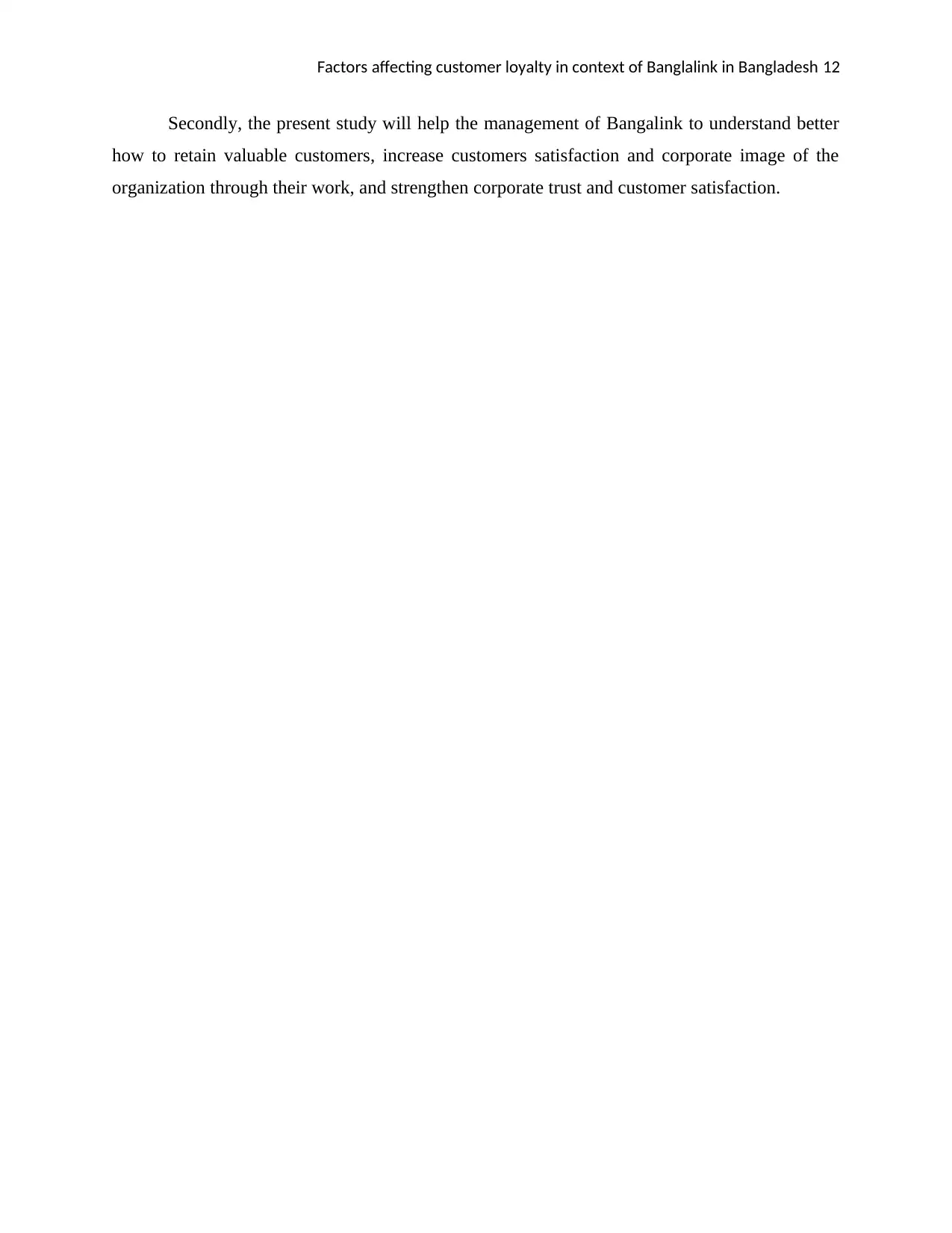
Factors affecting customer loyalty in context of Banglalink in Bangladesh 12
Secondly, the present study will help the management of Bangalink to understand better
how to retain valuable customers, increase customers satisfaction and corporate image of the
organization through their work, and strengthen corporate trust and customer satisfaction.
Secondly, the present study will help the management of Bangalink to understand better
how to retain valuable customers, increase customers satisfaction and corporate image of the
organization through their work, and strengthen corporate trust and customer satisfaction.
Paraphrase This Document
Need a fresh take? Get an instant paraphrase of this document with our AI Paraphraser
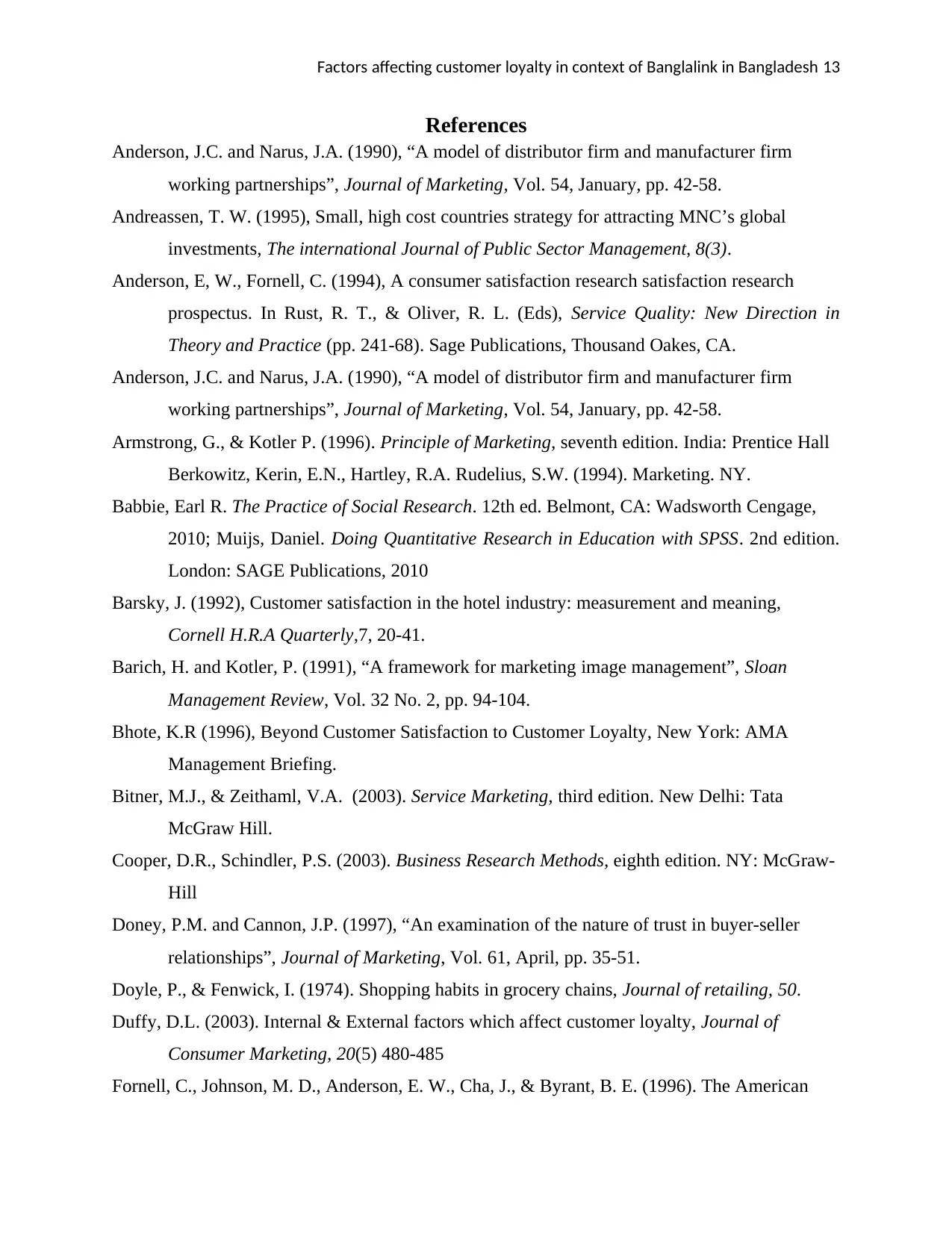
Factors affecting customer loyalty in context of Banglalink in Bangladesh 13
References
Anderson, J.C. and Narus, J.A. (1990), “A model of distributor firm and manufacturer firm
working partnerships”, Journal of Marketing, Vol. 54, January, pp. 42-58.
Andreassen, T. W. (1995), Small, high cost countries strategy for attracting MNC’s global
investments, The international Journal of Public Sector Management, 8(3).
Anderson, E, W., Fornell, C. (1994), A consumer satisfaction research satisfaction research
prospectus. In Rust, R. T., & Oliver, R. L. (Eds), Service Quality: New Direction in
Theory and Practice (pp. 241-68). Sage Publications, Thousand Oakes, CA.
Anderson, J.C. and Narus, J.A. (1990), “A model of distributor firm and manufacturer firm
working partnerships”, Journal of Marketing, Vol. 54, January, pp. 42-58.
Armstrong, G., & Kotler P. (1996). Principle of Marketing, seventh edition. India: Prentice Hall
Berkowitz, Kerin, E.N., Hartley, R.A. Rudelius, S.W. (1994). Marketing. NY.
Babbie, Earl R. The Practice of Social Research. 12th ed. Belmont, CA: Wadsworth Cengage,
2010; Muijs, Daniel. Doing Quantitative Research in Education with SPSS. 2nd edition.
London: SAGE Publications, 2010
Barsky, J. (1992), Customer satisfaction in the hotel industry: measurement and meaning,
Cornell H.R.A Quarterly,7, 20-41.
Barich, H. and Kotler, P. (1991), “A framework for marketing image management”, Sloan
Management Review, Vol. 32 No. 2, pp. 94-104.
Bhote, K.R (1996), Beyond Customer Satisfaction to Customer Loyalty, New York: AMA
Management Briefing.
Bitner, M.J., & Zeithaml, V.A. (2003). Service Marketing, third edition. New Delhi: Tata
McGraw Hill.
Cooper, D.R., Schindler, P.S. (2003). Business Research Methods, eighth edition. NY: McGraw-
Hill
Doney, P.M. and Cannon, J.P. (1997), “An examination of the nature of trust in buyer-seller
relationships”, Journal of Marketing, Vol. 61, April, pp. 35-51.
Doyle, P., & Fenwick, I. (1974). Shopping habits in grocery chains, Journal of retailing, 50.
Duffy, D.L. (2003). Internal & External factors which affect customer loyalty, Journal of
Consumer Marketing, 20(5) 480-485
Fornell, C., Johnson, M. D., Anderson, E. W., Cha, J., & Byrant, B. E. (1996). The American
References
Anderson, J.C. and Narus, J.A. (1990), “A model of distributor firm and manufacturer firm
working partnerships”, Journal of Marketing, Vol. 54, January, pp. 42-58.
Andreassen, T. W. (1995), Small, high cost countries strategy for attracting MNC’s global
investments, The international Journal of Public Sector Management, 8(3).
Anderson, E, W., Fornell, C. (1994), A consumer satisfaction research satisfaction research
prospectus. In Rust, R. T., & Oliver, R. L. (Eds), Service Quality: New Direction in
Theory and Practice (pp. 241-68). Sage Publications, Thousand Oakes, CA.
Anderson, J.C. and Narus, J.A. (1990), “A model of distributor firm and manufacturer firm
working partnerships”, Journal of Marketing, Vol. 54, January, pp. 42-58.
Armstrong, G., & Kotler P. (1996). Principle of Marketing, seventh edition. India: Prentice Hall
Berkowitz, Kerin, E.N., Hartley, R.A. Rudelius, S.W. (1994). Marketing. NY.
Babbie, Earl R. The Practice of Social Research. 12th ed. Belmont, CA: Wadsworth Cengage,
2010; Muijs, Daniel. Doing Quantitative Research in Education with SPSS. 2nd edition.
London: SAGE Publications, 2010
Barsky, J. (1992), Customer satisfaction in the hotel industry: measurement and meaning,
Cornell H.R.A Quarterly,7, 20-41.
Barich, H. and Kotler, P. (1991), “A framework for marketing image management”, Sloan
Management Review, Vol. 32 No. 2, pp. 94-104.
Bhote, K.R (1996), Beyond Customer Satisfaction to Customer Loyalty, New York: AMA
Management Briefing.
Bitner, M.J., & Zeithaml, V.A. (2003). Service Marketing, third edition. New Delhi: Tata
McGraw Hill.
Cooper, D.R., Schindler, P.S. (2003). Business Research Methods, eighth edition. NY: McGraw-
Hill
Doney, P.M. and Cannon, J.P. (1997), “An examination of the nature of trust in buyer-seller
relationships”, Journal of Marketing, Vol. 61, April, pp. 35-51.
Doyle, P., & Fenwick, I. (1974). Shopping habits in grocery chains, Journal of retailing, 50.
Duffy, D.L. (2003). Internal & External factors which affect customer loyalty, Journal of
Consumer Marketing, 20(5) 480-485
Fornell, C., Johnson, M. D., Anderson, E. W., Cha, J., & Byrant, B. E. (1996). The American
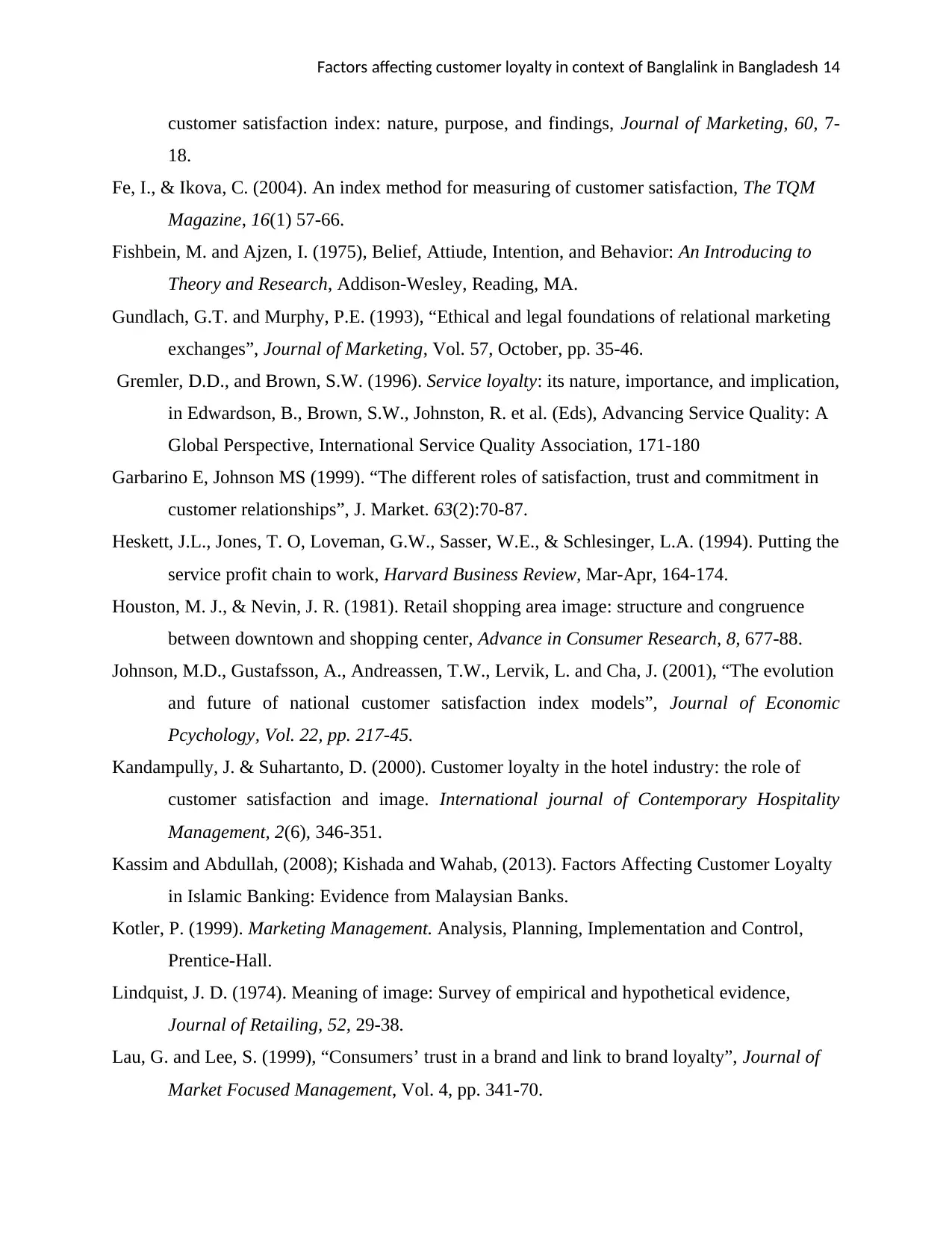
Factors affecting customer loyalty in context of Banglalink in Bangladesh 14
customer satisfaction index: nature, purpose, and findings, Journal of Marketing, 60, 7-
18.
Fe, I., & Ikova, C. (2004). An index method for measuring of customer satisfaction, The TQM
Magazine, 16(1) 57-66.
Fishbein, M. and Ajzen, I. (1975), Belief, Attiude, Intention, and Behavior: An Introducing to
Theory and Research, Addison-Wesley, Reading, MA.
Gundlach, G.T. and Murphy, P.E. (1993), “Ethical and legal foundations of relational marketing
exchanges”, Journal of Marketing, Vol. 57, October, pp. 35-46.
Gremler, D.D., and Brown, S.W. (1996). Service loyalty: its nature, importance, and implication,
in Edwardson, B., Brown, S.W., Johnston, R. et al. (Eds), Advancing Service Quality: A
Global Perspective, International Service Quality Association, 171-180
Garbarino E, Johnson MS (1999). “The different roles of satisfaction, trust and commitment in
customer relationships”, J. Market. 63(2):70-87.
Heskett, J.L., Jones, T. O, Loveman, G.W., Sasser, W.E., & Schlesinger, L.A. (1994). Putting the
service profit chain to work, Harvard Business Review, Mar-Apr, 164-174.
Houston, M. J., & Nevin, J. R. (1981). Retail shopping area image: structure and congruence
between downtown and shopping center, Advance in Consumer Research, 8, 677-88.
Johnson, M.D., Gustafsson, A., Andreassen, T.W., Lervik, L. and Cha, J. (2001), “The evolution
and future of national customer satisfaction index models”, Journal of Economic
Pcychology, Vol. 22, pp. 217-45.
Kandampully, J. & Suhartanto, D. (2000). Customer loyalty in the hotel industry: the role of
customer satisfaction and image. International journal of Contemporary Hospitality
Management, 2(6), 346-351.
Kassim and Abdullah, (2008); Kishada and Wahab, (2013). Factors Affecting Customer Loyalty
in Islamic Banking: Evidence from Malaysian Banks.
Kotler, P. (1999). Marketing Management. Analysis, Planning, Implementation and Control,
Prentice-Hall.
Lindquist, J. D. (1974). Meaning of image: Survey of empirical and hypothetical evidence,
Journal of Retailing, 52, 29-38.
Lau, G. and Lee, S. (1999), “Consumers’ trust in a brand and link to brand loyalty”, Journal of
Market Focused Management, Vol. 4, pp. 341-70.
customer satisfaction index: nature, purpose, and findings, Journal of Marketing, 60, 7-
18.
Fe, I., & Ikova, C. (2004). An index method for measuring of customer satisfaction, The TQM
Magazine, 16(1) 57-66.
Fishbein, M. and Ajzen, I. (1975), Belief, Attiude, Intention, and Behavior: An Introducing to
Theory and Research, Addison-Wesley, Reading, MA.
Gundlach, G.T. and Murphy, P.E. (1993), “Ethical and legal foundations of relational marketing
exchanges”, Journal of Marketing, Vol. 57, October, pp. 35-46.
Gremler, D.D., and Brown, S.W. (1996). Service loyalty: its nature, importance, and implication,
in Edwardson, B., Brown, S.W., Johnston, R. et al. (Eds), Advancing Service Quality: A
Global Perspective, International Service Quality Association, 171-180
Garbarino E, Johnson MS (1999). “The different roles of satisfaction, trust and commitment in
customer relationships”, J. Market. 63(2):70-87.
Heskett, J.L., Jones, T. O, Loveman, G.W., Sasser, W.E., & Schlesinger, L.A. (1994). Putting the
service profit chain to work, Harvard Business Review, Mar-Apr, 164-174.
Houston, M. J., & Nevin, J. R. (1981). Retail shopping area image: structure and congruence
between downtown and shopping center, Advance in Consumer Research, 8, 677-88.
Johnson, M.D., Gustafsson, A., Andreassen, T.W., Lervik, L. and Cha, J. (2001), “The evolution
and future of national customer satisfaction index models”, Journal of Economic
Pcychology, Vol. 22, pp. 217-45.
Kandampully, J. & Suhartanto, D. (2000). Customer loyalty in the hotel industry: the role of
customer satisfaction and image. International journal of Contemporary Hospitality
Management, 2(6), 346-351.
Kassim and Abdullah, (2008); Kishada and Wahab, (2013). Factors Affecting Customer Loyalty
in Islamic Banking: Evidence from Malaysian Banks.
Kotler, P. (1999). Marketing Management. Analysis, Planning, Implementation and Control,
Prentice-Hall.
Lindquist, J. D. (1974). Meaning of image: Survey of empirical and hypothetical evidence,
Journal of Retailing, 52, 29-38.
Lau, G. and Lee, S. (1999), “Consumers’ trust in a brand and link to brand loyalty”, Journal of
Market Focused Management, Vol. 4, pp. 341-70.
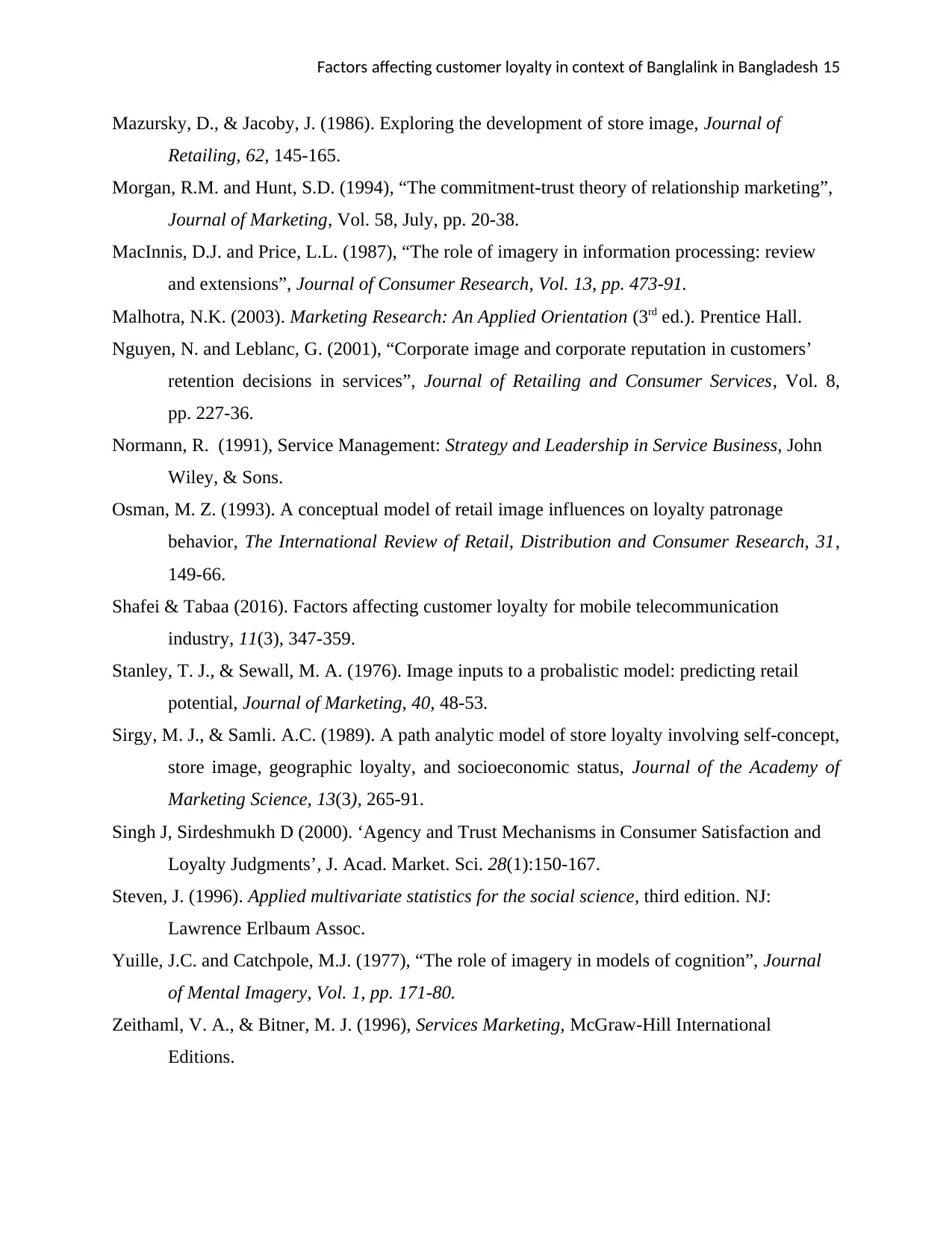
Factors affecting customer loyalty in context of Banglalink in Bangladesh 15
Mazursky, D., & Jacoby, J. (1986). Exploring the development of store image, Journal of
Retailing, 62, 145-165.
Morgan, R.M. and Hunt, S.D. (1994), “The commitment-trust theory of relationship marketing”,
Journal of Marketing, Vol. 58, July, pp. 20-38.
MacInnis, D.J. and Price, L.L. (1987), “The role of imagery in information processing: review
and extensions”, Journal of Consumer Research, Vol. 13, pp. 473-91.
Malhotra, N.K. (2003). Marketing Research: An Applied Orientation (3rd ed.). Prentice Hall.
Nguyen, N. and Leblanc, G. (2001), “Corporate image and corporate reputation in customers’
retention decisions in services”, Journal of Retailing and Consumer Services, Vol. 8,
pp. 227-36.
Normann, R. (1991), Service Management: Strategy and Leadership in Service Business, John
Wiley, & Sons.
Osman, M. Z. (1993). A conceptual model of retail image influences on loyalty patronage
behavior, The International Review of Retail, Distribution and Consumer Research, 31,
149-66.
Shafei & Tabaa (2016). Factors affecting customer loyalty for mobile telecommunication
industry, 11(3), 347-359.
Stanley, T. J., & Sewall, M. A. (1976). Image inputs to a probalistic model: predicting retail
potential, Journal of Marketing, 40, 48-53.
Sirgy, M. J., & Samli. A.C. (1989). A path analytic model of store loyalty involving self-concept,
store image, geographic loyalty, and socioeconomic status, Journal of the Academy of
Marketing Science, 13(3), 265-91.
Singh J, Sirdeshmukh D (2000). ‘Agency and Trust Mechanisms in Consumer Satisfaction and
Loyalty Judgments’, J. Acad. Market. Sci. 28(1):150-167.
Steven, J. (1996). Applied multivariate statistics for the social science, third edition. NJ:
Lawrence Erlbaum Assoc.
Yuille, J.C. and Catchpole, M.J. (1977), “The role of imagery in models of cognition”, Journal
of Mental Imagery, Vol. 1, pp. 171-80.
Zeithaml, V. A., & Bitner, M. J. (1996), Services Marketing, McGraw-Hill International
Editions.
Mazursky, D., & Jacoby, J. (1986). Exploring the development of store image, Journal of
Retailing, 62, 145-165.
Morgan, R.M. and Hunt, S.D. (1994), “The commitment-trust theory of relationship marketing”,
Journal of Marketing, Vol. 58, July, pp. 20-38.
MacInnis, D.J. and Price, L.L. (1987), “The role of imagery in information processing: review
and extensions”, Journal of Consumer Research, Vol. 13, pp. 473-91.
Malhotra, N.K. (2003). Marketing Research: An Applied Orientation (3rd ed.). Prentice Hall.
Nguyen, N. and Leblanc, G. (2001), “Corporate image and corporate reputation in customers’
retention decisions in services”, Journal of Retailing and Consumer Services, Vol. 8,
pp. 227-36.
Normann, R. (1991), Service Management: Strategy and Leadership in Service Business, John
Wiley, & Sons.
Osman, M. Z. (1993). A conceptual model of retail image influences on loyalty patronage
behavior, The International Review of Retail, Distribution and Consumer Research, 31,
149-66.
Shafei & Tabaa (2016). Factors affecting customer loyalty for mobile telecommunication
industry, 11(3), 347-359.
Stanley, T. J., & Sewall, M. A. (1976). Image inputs to a probalistic model: predicting retail
potential, Journal of Marketing, 40, 48-53.
Sirgy, M. J., & Samli. A.C. (1989). A path analytic model of store loyalty involving self-concept,
store image, geographic loyalty, and socioeconomic status, Journal of the Academy of
Marketing Science, 13(3), 265-91.
Singh J, Sirdeshmukh D (2000). ‘Agency and Trust Mechanisms in Consumer Satisfaction and
Loyalty Judgments’, J. Acad. Market. Sci. 28(1):150-167.
Steven, J. (1996). Applied multivariate statistics for the social science, third edition. NJ:
Lawrence Erlbaum Assoc.
Yuille, J.C. and Catchpole, M.J. (1977), “The role of imagery in models of cognition”, Journal
of Mental Imagery, Vol. 1, pp. 171-80.
Zeithaml, V. A., & Bitner, M. J. (1996), Services Marketing, McGraw-Hill International
Editions.
Secure Best Marks with AI Grader
Need help grading? Try our AI Grader for instant feedback on your assignments.
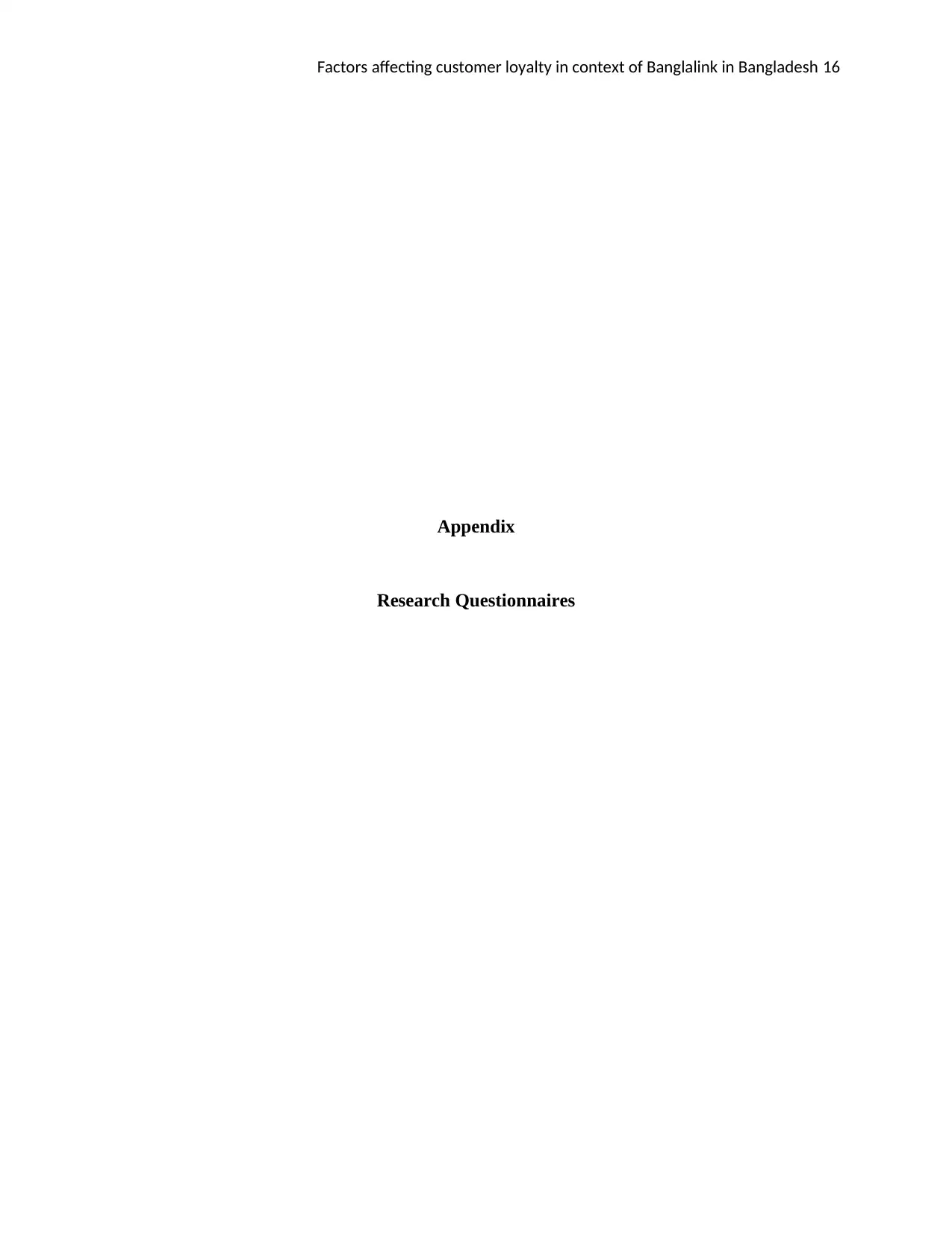
Factors affecting customer loyalty in context of Banglalink in Bangladesh 16
Appendix
Research Questionnaires
Appendix
Research Questionnaires
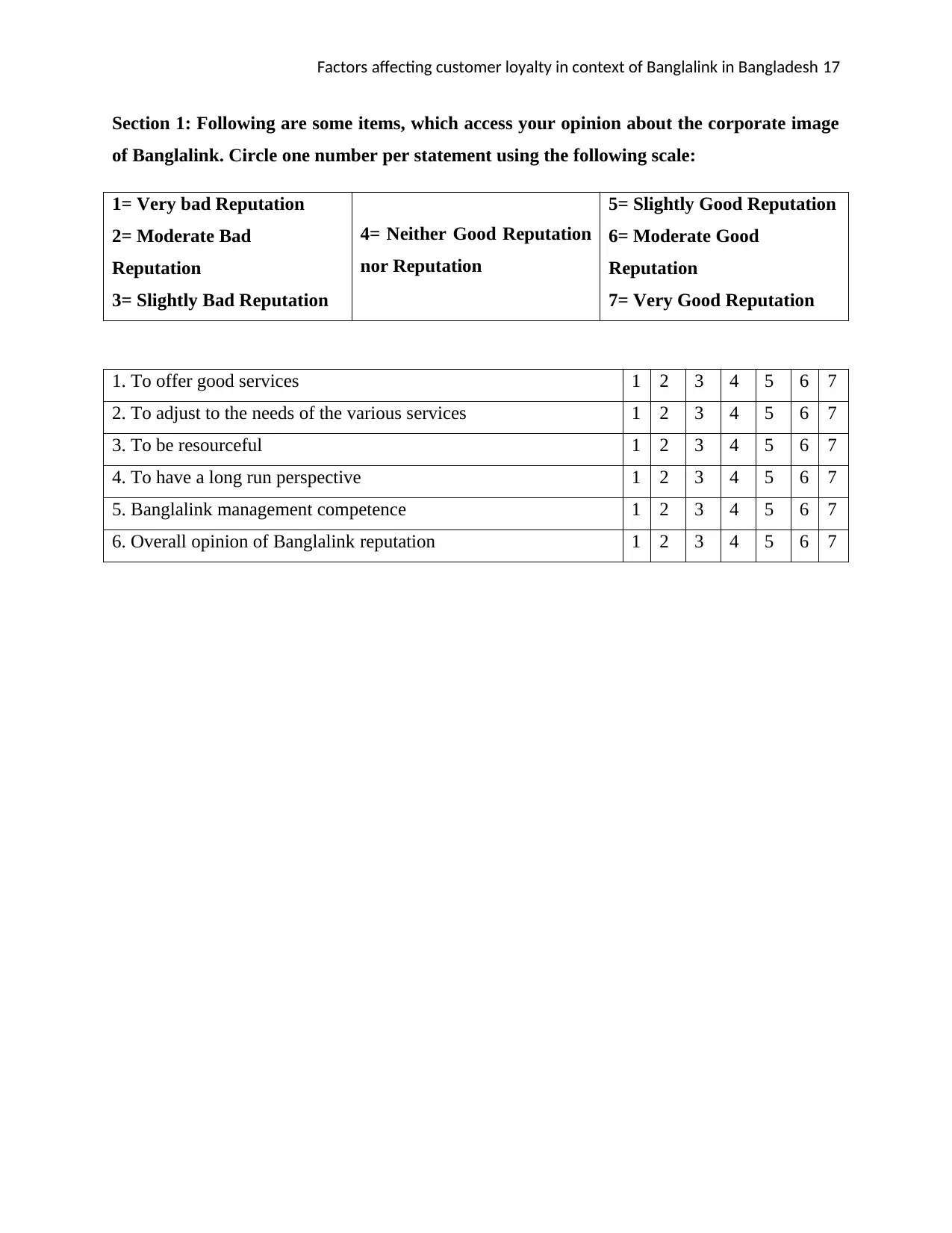
Factors affecting customer loyalty in context of Banglalink in Bangladesh 17
Section 1: Following are some items, which access your opinion about the corporate image
of Banglalink. Circle one number per statement using the following scale:
1= Very bad Reputation
2= Moderate Bad
Reputation
3= Slightly Bad Reputation
4= Neither Good Reputation
nor Reputation
5= Slightly Good Reputation
6= Moderate Good
Reputation
7= Very Good Reputation
1. To offer good services 1 2 3 4 5 6 7
2. To adjust to the needs of the various services 1 2 3 4 5 6 7
3. To be resourceful 1 2 3 4 5 6 7
4. To have a long run perspective 1 2 3 4 5 6 7
5. Banglalink management competence 1 2 3 4 5 6 7
6. Overall opinion of Banglalink reputation 1 2 3 4 5 6 7
Section 1: Following are some items, which access your opinion about the corporate image
of Banglalink. Circle one number per statement using the following scale:
1= Very bad Reputation
2= Moderate Bad
Reputation
3= Slightly Bad Reputation
4= Neither Good Reputation
nor Reputation
5= Slightly Good Reputation
6= Moderate Good
Reputation
7= Very Good Reputation
1. To offer good services 1 2 3 4 5 6 7
2. To adjust to the needs of the various services 1 2 3 4 5 6 7
3. To be resourceful 1 2 3 4 5 6 7
4. To have a long run perspective 1 2 3 4 5 6 7
5. Banglalink management competence 1 2 3 4 5 6 7
6. Overall opinion of Banglalink reputation 1 2 3 4 5 6 7
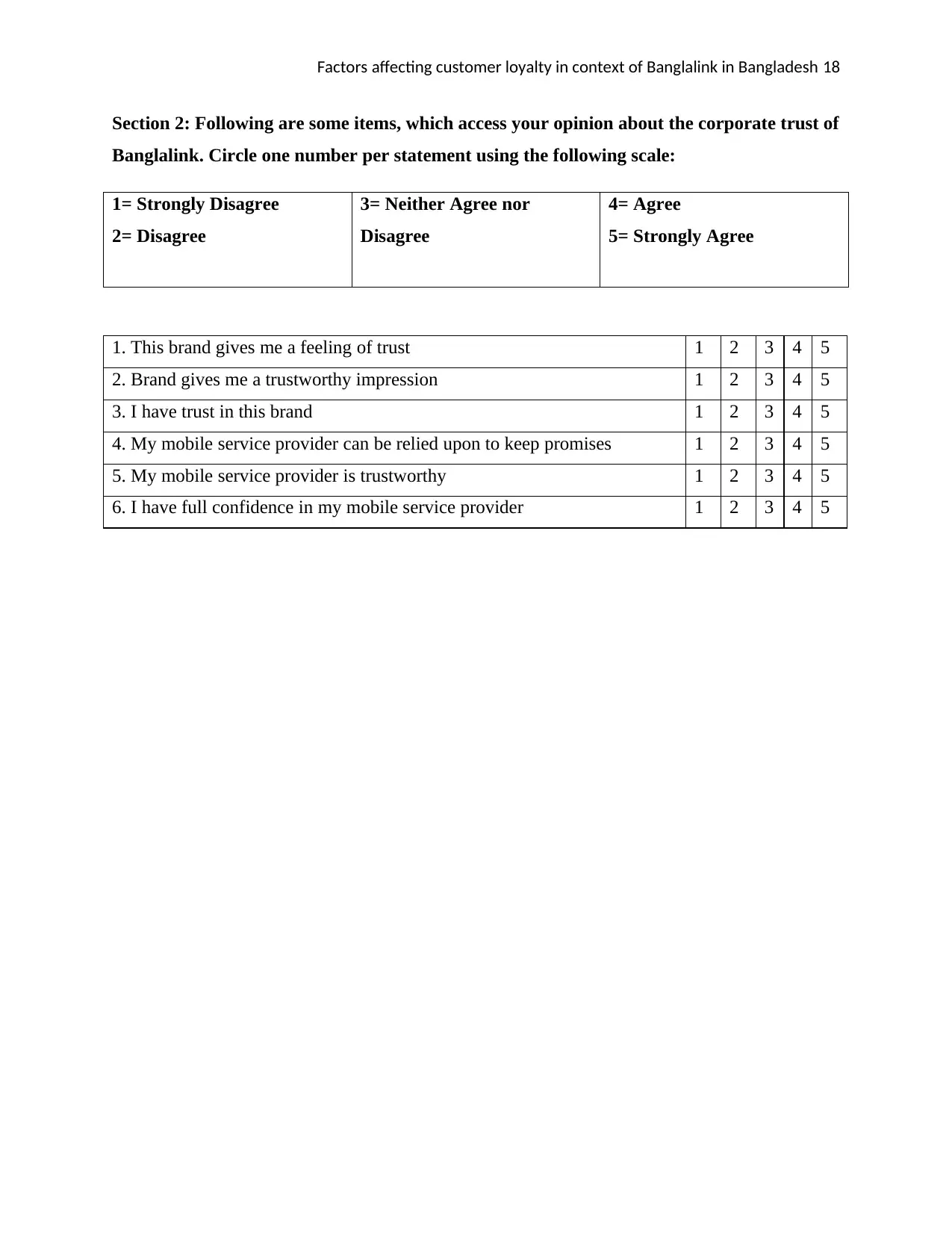
Factors affecting customer loyalty in context of Banglalink in Bangladesh 18
Section 2: Following are some items, which access your opinion about the corporate trust of
Banglalink. Circle one number per statement using the following scale:
1= Strongly Disagree
2= Disagree
3= Neither Agree nor
Disagree
4= Agree
5= Strongly Agree
1. This brand gives me a feeling of trust 1 2 3 4 5
2. Brand gives me a trustworthy impression 1 2 3 4 5
3. I have trust in this brand 1 2 3 4 5
4. My mobile service provider can be relied upon to keep promises 1 2 3 4 5
5. My mobile service provider is trustworthy 1 2 3 4 5
6. I have full confidence in my mobile service provider 1 2 3 4 5
Section 2: Following are some items, which access your opinion about the corporate trust of
Banglalink. Circle one number per statement using the following scale:
1= Strongly Disagree
2= Disagree
3= Neither Agree nor
Disagree
4= Agree
5= Strongly Agree
1. This brand gives me a feeling of trust 1 2 3 4 5
2. Brand gives me a trustworthy impression 1 2 3 4 5
3. I have trust in this brand 1 2 3 4 5
4. My mobile service provider can be relied upon to keep promises 1 2 3 4 5
5. My mobile service provider is trustworthy 1 2 3 4 5
6. I have full confidence in my mobile service provider 1 2 3 4 5
Paraphrase This Document
Need a fresh take? Get an instant paraphrase of this document with our AI Paraphraser
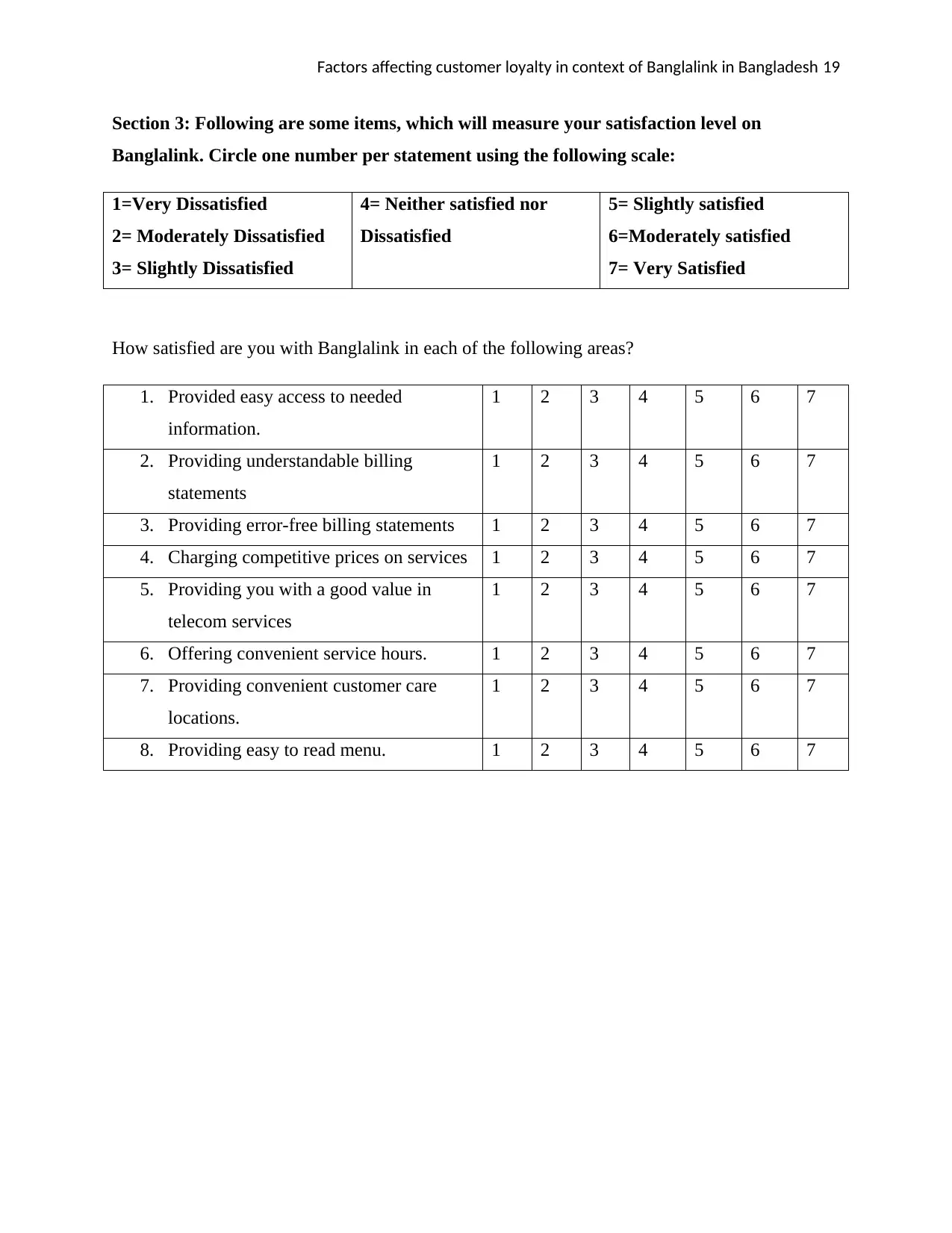
Factors affecting customer loyalty in context of Banglalink in Bangladesh 19
Section 3: Following are some items, which will measure your satisfaction level on
Banglalink. Circle one number per statement using the following scale:
1=Very Dissatisfied
2= Moderately Dissatisfied
3= Slightly Dissatisfied
4= Neither satisfied nor
Dissatisfied
5= Slightly satisfied
6=Moderately satisfied
7= Very Satisfied
How satisfied are you with Banglalink in each of the following areas?
1. Provided easy access to needed
information.
1 2 3 4 5 6 7
2. Providing understandable billing
statements
1 2 3 4 5 6 7
3. Providing error-free billing statements 1 2 3 4 5 6 7
4. Charging competitive prices on services 1 2 3 4 5 6 7
5. Providing you with a good value in
telecom services
1 2 3 4 5 6 7
6. Offering convenient service hours. 1 2 3 4 5 6 7
7. Providing convenient customer care
locations.
1 2 3 4 5 6 7
8. Providing easy to read menu. 1 2 3 4 5 6 7
Section 3: Following are some items, which will measure your satisfaction level on
Banglalink. Circle one number per statement using the following scale:
1=Very Dissatisfied
2= Moderately Dissatisfied
3= Slightly Dissatisfied
4= Neither satisfied nor
Dissatisfied
5= Slightly satisfied
6=Moderately satisfied
7= Very Satisfied
How satisfied are you with Banglalink in each of the following areas?
1. Provided easy access to needed
information.
1 2 3 4 5 6 7
2. Providing understandable billing
statements
1 2 3 4 5 6 7
3. Providing error-free billing statements 1 2 3 4 5 6 7
4. Charging competitive prices on services 1 2 3 4 5 6 7
5. Providing you with a good value in
telecom services
1 2 3 4 5 6 7
6. Offering convenient service hours. 1 2 3 4 5 6 7
7. Providing convenient customer care
locations.
1 2 3 4 5 6 7
8. Providing easy to read menu. 1 2 3 4 5 6 7
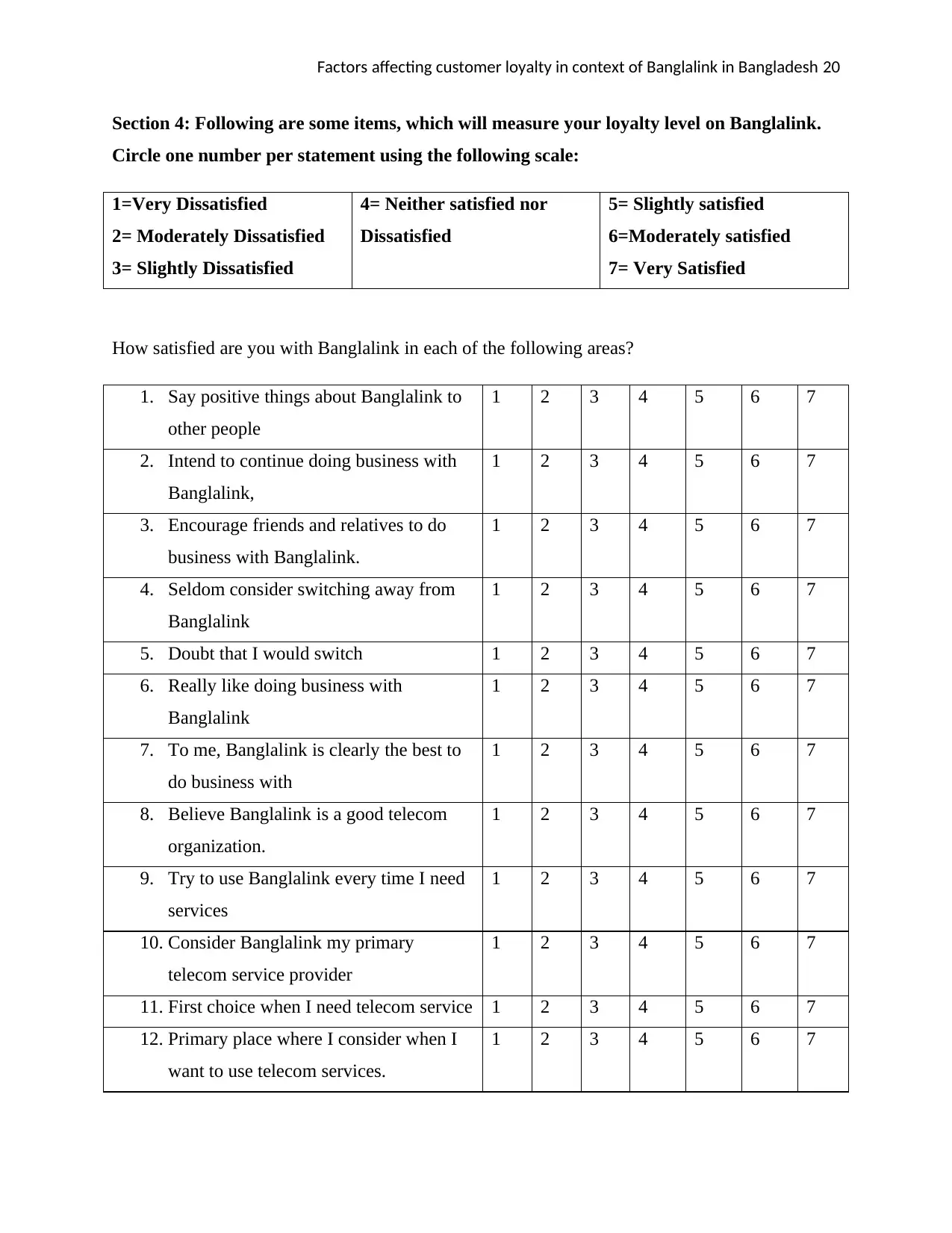
Factors affecting customer loyalty in context of Banglalink in Bangladesh 20
Section 4: Following are some items, which will measure your loyalty level on Banglalink.
Circle one number per statement using the following scale:
1=Very Dissatisfied
2= Moderately Dissatisfied
3= Slightly Dissatisfied
4= Neither satisfied nor
Dissatisfied
5= Slightly satisfied
6=Moderately satisfied
7= Very Satisfied
How satisfied are you with Banglalink in each of the following areas?
1. Say positive things about Banglalink to
other people
1 2 3 4 5 6 7
2. Intend to continue doing business with
Banglalink,
1 2 3 4 5 6 7
3. Encourage friends and relatives to do
business with Banglalink.
1 2 3 4 5 6 7
4. Seldom consider switching away from
Banglalink
1 2 3 4 5 6 7
5. Doubt that I would switch 1 2 3 4 5 6 7
6. Really like doing business with
Banglalink
1 2 3 4 5 6 7
7. To me, Banglalink is clearly the best to
do business with
1 2 3 4 5 6 7
8. Believe Banglalink is a good telecom
organization.
1 2 3 4 5 6 7
9. Try to use Banglalink every time I need
services
1 2 3 4 5 6 7
10. Consider Banglalink my primary
telecom service provider
1 2 3 4 5 6 7
11. First choice when I need telecom service 1 2 3 4 5 6 7
12. Primary place where I consider when I
want to use telecom services.
1 2 3 4 5 6 7
Section 4: Following are some items, which will measure your loyalty level on Banglalink.
Circle one number per statement using the following scale:
1=Very Dissatisfied
2= Moderately Dissatisfied
3= Slightly Dissatisfied
4= Neither satisfied nor
Dissatisfied
5= Slightly satisfied
6=Moderately satisfied
7= Very Satisfied
How satisfied are you with Banglalink in each of the following areas?
1. Say positive things about Banglalink to
other people
1 2 3 4 5 6 7
2. Intend to continue doing business with
Banglalink,
1 2 3 4 5 6 7
3. Encourage friends and relatives to do
business with Banglalink.
1 2 3 4 5 6 7
4. Seldom consider switching away from
Banglalink
1 2 3 4 5 6 7
5. Doubt that I would switch 1 2 3 4 5 6 7
6. Really like doing business with
Banglalink
1 2 3 4 5 6 7
7. To me, Banglalink is clearly the best to
do business with
1 2 3 4 5 6 7
8. Believe Banglalink is a good telecom
organization.
1 2 3 4 5 6 7
9. Try to use Banglalink every time I need
services
1 2 3 4 5 6 7
10. Consider Banglalink my primary
telecom service provider
1 2 3 4 5 6 7
11. First choice when I need telecom service 1 2 3 4 5 6 7
12. Primary place where I consider when I
want to use telecom services.
1 2 3 4 5 6 7
1 out of 21
Related Documents
Your All-in-One AI-Powered Toolkit for Academic Success.
+13062052269
info@desklib.com
Available 24*7 on WhatsApp / Email
![[object Object]](/_next/static/media/star-bottom.7253800d.svg)
Unlock your academic potential
© 2024 | Zucol Services PVT LTD | All rights reserved.





